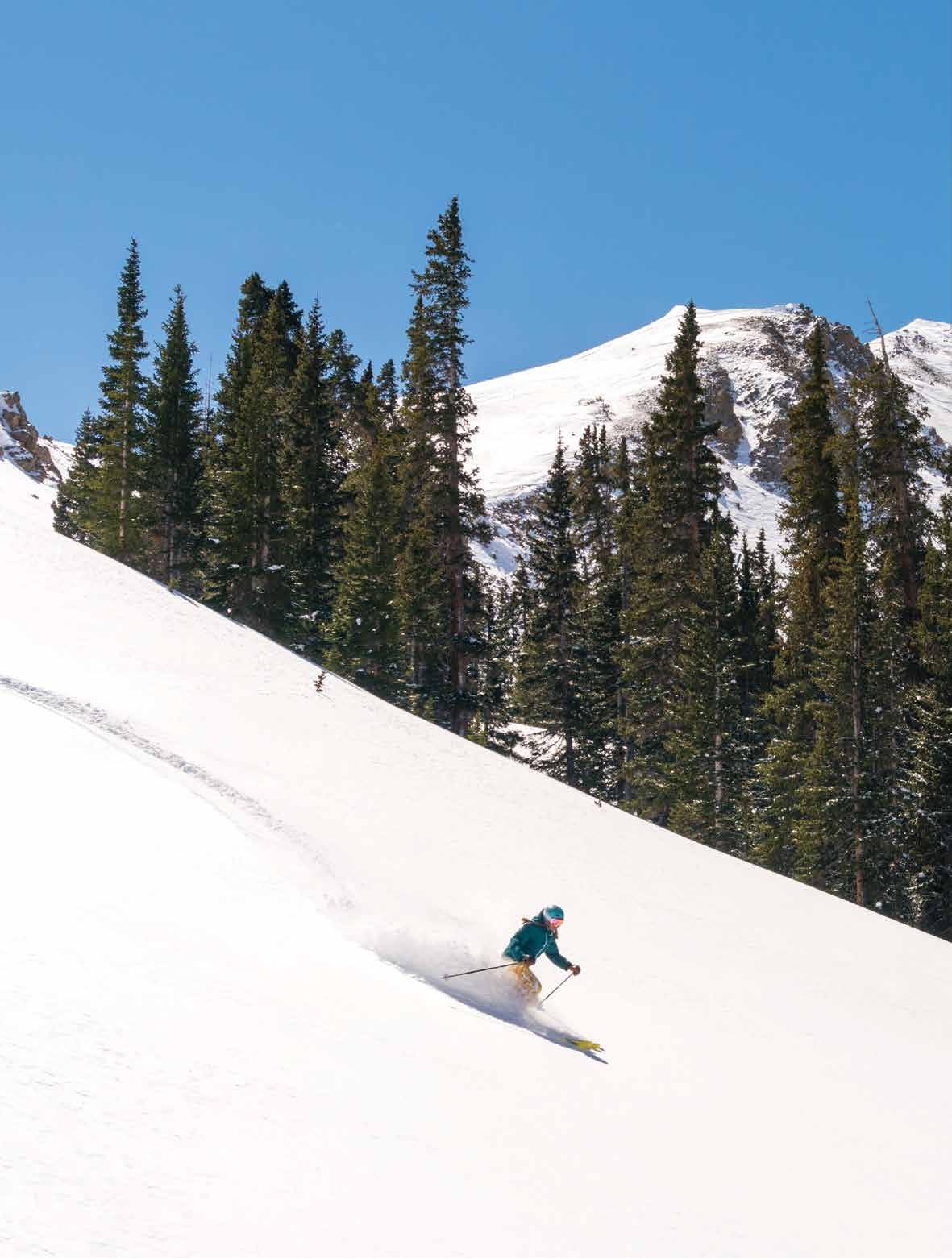




























Why does snow get all of the attention? Colorado’s ice is pretty spectacular too.

Whether you’re heading to an outdoor skating rink, looking for advice on how to pack your vehicle for a winter road trip, or trying to discover when the next big blizzard will hit, OutThere Colorado has you covered.
From relevant news to adventure inspiration to tips for safe travel, our content on OutThereColorado.com is created by people who are passionate about what they’re covering. We want you to have a great and memorable Colorado winter, whether that’s on or off the slopes.
Inside this magazine, you’ll find recommendations that will make adventure more accessible, even as the winter weather roars. And don’t forget to head to OutThereColorado.com for fresh new content posted each day.
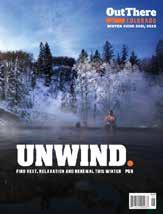
10 12 20 22 25 34 40 42
REST AND RELAXATION
Four destinations that showcase hot springs
WINTER PLAYGROUND
Durango heats up with activities in the cold

A GROWING FISH STORY
Niche sport of ice fishing continues to expand
LEAVE THE SKIS AT HOME
This epic road trip doesn’t require a lift ticket
POWDER PREVIEW
A detailed breakdown of Colorado’s ski areas
A GRAND DESTINATION
Plan a winter vacation in scenic Grand Lake
REV UP YOUR ENGINE
Snowmobile adventure laden with adrenaline



MILD SIDE OF WINTER
Hit the road and escape most of the snow
Spencer McKee
Director of Content and Operations


Tamera Twitty Digital Content Creator
Sam Schoenecker Digital Content Specialist
Nichole Montanez Magazine Designer
Nathan Van Dyne Magazine Editor
Christian Murdock Magazine Photographer
Seth Boster Magazine Reporter
CONTACT
info@outtherecolorado.com facebook.com/outtherecolorado instagram.com/outtherecolorado twitter.com/outthereco pinterest.com/outthereco

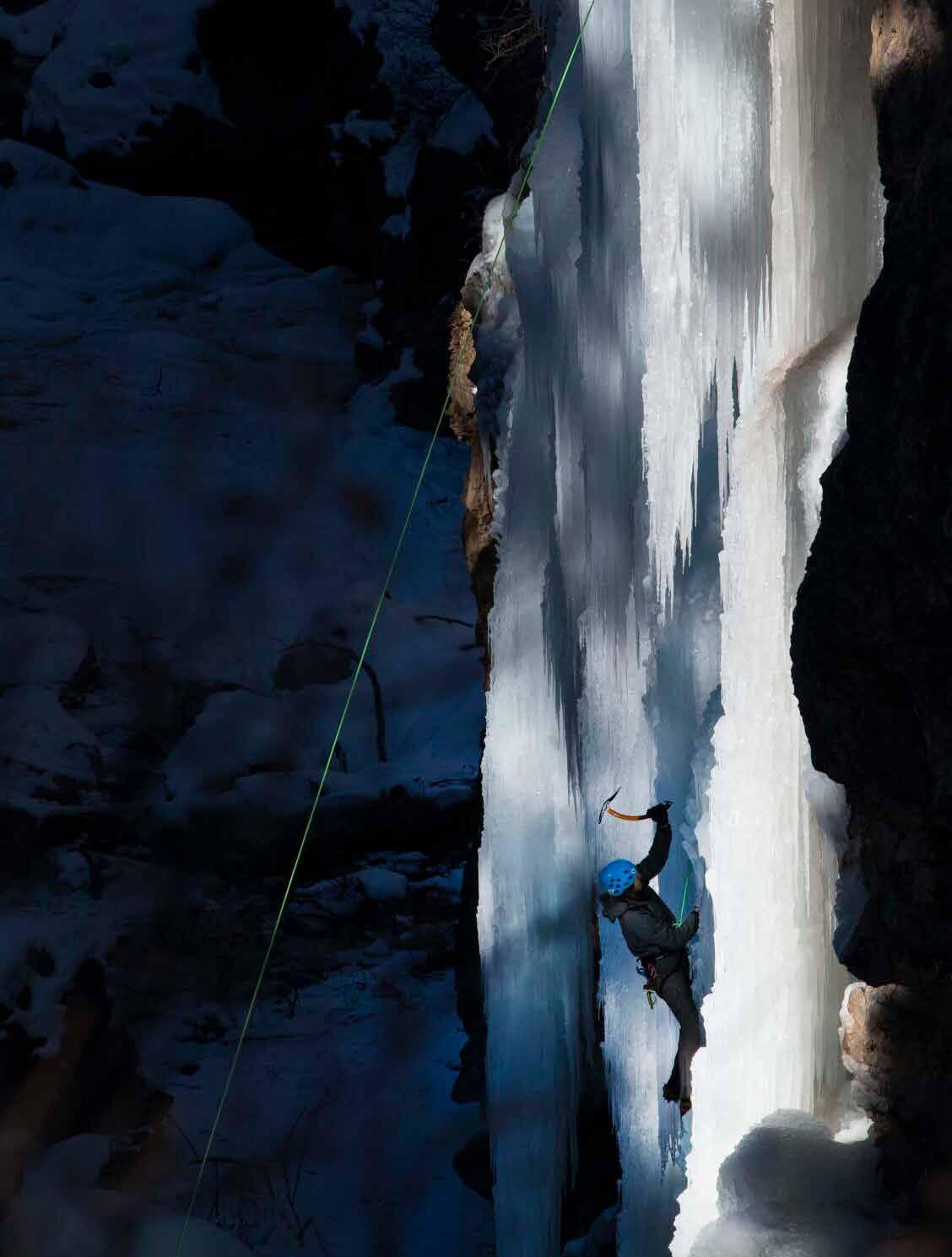
UNDERSCORE IMPORTANCE OF PRECIOUS WINTER COMMODITY
LOW SUPPLY AND HIGH DEMAND
By Seth Boster Ouray Ice Park. Christian MurdockUnlike skiers, it’s not a bluebird day that’s desired. Bring on the cloud cover, say ice climbers and ice fishermen and ice skaters and any other strain of this state’s colorful, ice-craving enthusiasts, from car racers to boat sailors also playing on rock-solid caps that melt under the sun.
There are hockey players, too. There are sculptors, too. There are everyday sightseers who long to admire ephemeral beauty that lasts only so long in these great outdoors: massive waterfalls gone breathtakingly silent, and caves and canyons transformed into blue, sparkling wonderlands.

Bring on the freeze, they all say. We’re embracing the cold like never before in our annual guide to Colorado winter. Yes, we’ll have plenty of skiing in this magazine. We’ll ramp up the temperature when it comes to hot springs. We’ll even take you to places around the state where you might escape winter.
But all the while, we’ll be making stops at the ice that is as core to Coloradans as the world-famous slopes. In fact, the demand for ice in this state long predates that for chairlifts.
Just as men rushed to these mountains for gold, they toiled on frozen waters with tools for carving out blocks. Ice houses popped up around the Front Range, built for storing the product needed by homes and businesses through the summer.
In 1860, ice was so hotly desired it inspired devious behavior. An ice harvesting company in Denver posted a $100 reward in the Rocky Mountain News: “We will pay the above reward for the detection of
It’s the soft stuff that rules. That powdery snow that conjures skiing dreams as soon as the air gets nippy.
But in no certain corners of Colorado, a hard element is equally cherished.Ice caves in rifle Mountain Park. Christian Murdock
the person or persons that are in the habit of breaking into our ice house on the bank of the lake above town.”
These days, while ice production has evolved dramatically, many still hold ice as dear as ever.
Take, for example, those who know the astonishing beauty of frozen lakes and waterfalls. Or those who know about Rifle’s ice caves on the Western Slope — just one cavernous wonder painted by Mother Nature in slippery, magnificent blue.
Or take the thousands who flock to an odd festival in honor of a frozen dead guy. Or the thousands who long for a return of the Cripple Creek Ice Festival. The formerly annual event celebrating icy artistry has yet to commence since the start of the pandemic.

Or take, for example, Jay Karst and Grant Wilson. Ice climbing has long been their way to satisfy adventurous, goal-oriented appetites.
“It started being objective-driven,” Karst said from his Colorado Springs home. “But I’ve reached a point here in the last five years or so where it’s started to be more about the camaraderie and the deep relationships you develop when you share a rope with someone on frozen water that could melt out at any time.”
Said Wilson, a Denver-based climber: “You’re in this entire world that’s this sphere of about 3 feet around you, and nothing else matters, and you don’t hear anything else. It’s a peace of mind that I just don’t think you can get anywhere else.”
As Colorado was coming into shape as a state, so too were blocks of ice cut from lakes, ponds and streams. Residents, after all, needed a way to preserve their perishables.
Indeed, the commodity wasn’t so easy to come by back then. Here’s a brief history of the industry that grew with the state’s biggest populations:
1860: Alden’s Hotel and Restaurant on Denver’s Blake Street advertises ice cream “kept constantly on hand.” Which begs the question: How is J.R. Alden preserving the cold snack year-round?
Perhaps from “a gentleman who has been for many years engaged in the Boston ice trade,” as the Rocky Mountain News reports this year. He is said to be “making preparations to store large quantity of that summer luxury in this city.”
Also this year, the paper writes of a Mr. Kershaw, “long of the Knickerbocker Ice Company of New York.” He reportedly employs men and horses to cut 8- to 12-inch blocks on a South Platte River-fed lake. The facility soon burns down and is swiftly rebuilt to meet the growing demand, as evidenced by Kershaw advertising a reward for someone “in the habit of breaking into our ice house.”
It’s a thrill as well. A thrill like the one a few brave boaters have gotten over the years at Dillon Reservoir in Summit County. They fix metal runners under their hulls and let the wind take their sails.
“It’s just crazy,” Tim Seeling said. “I mean, your butt is only 6 inches off the ice, your head is maybe a foot off the ice, and maybe you’re going 80 mph.”
Anglers prefer the slow lane. They’ll bundle up, drill a hole and take a seat atop frozen lakes, waiting for a bite on the line.

“You can look down at that hole and it’s like watching an aquarium,” said Robby Richardson, a guide based in Gunnison. “You see the fish come up and approach your bait. ... It’s kind of captivating getting that perspective that you can never get on a boat or from shore.”
He’s seen his sport “explode” in recent years, as have ice climbers. Some credit that to the rise of a premier venue in southwest Colorado: Ouray Ice Park.
Every winter, thousands descend upon the town tucked in a box canyon, where ice is farmed to create towering curtains and daggers. Visiting climbers have helped to enliven Ouray’s once-dead low-season economy.
“It is a precious asset for the city of Ouray and I would argue for the state of Colorado. There really is nothing else like it,” Ouray Ice Park’s executive director Peter O’Neil said. “It is precious, and it depends on two things: water and freezing temperatures.”
He hopes to have figured out the first with a water supply replacing the town’s dwindling tank. As for the temperatures, O’Neil can’t be sure.
“City Council got all sorts of complaints in late December (last year) because the ice park wasn’t open,” he said. “Talk to people who’ve been around 10-15 years, they will tell you we’ve been opening later every year.”
Late 1800s: In Fremont County, the ice industry booms to become a premier source shipping beyond state lines. Insulated ice houses are built along Sell’s Lake and Grape Creek to serve Cañon City.
Early 1900s: Thomas Hanks and W.E. Doyle lease the shores of Monument Lake, then called State Reservoir. Hanks and Doyle Ice Co. builds a plant with timber from Black Forest and harvests ice to be shipped to Denver and Pueblo.
“In ice harvest days, the winters were COLD!” reads an account by the Palmer Lake Historical Society. “From the first of November, Monument could always plan on the weather to range from 10- to 20-below zero every night.”
For several weeks in winter, upward of 50 men are hired and join horses to cut and pack ice on sawdust. They make 40 cents per hour, according to the historical society. Thousands of tons are stored and sold to homes and businesses.
It certainly seems that way to those tending to what’s considered North America’s biggest lake groomed for skating. Last year a group of men in denver hold tools to cut ice.
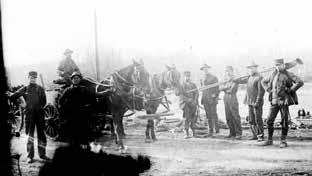
in Evergreen, Zamboni-driving Heart Cameron and his crew missed the goal of getting families on the ice by Christmas — a tradition as old as 1928, when Evergreen Lake was dammed.

“When I first started here, we would start seeing it freeze up toward the end of October,” said Cameron, who’s been on the job more than 20 years. “Recently, it’s gone deep into November.”
People around town couldn’t remember a time the lake thawed in December, as it did last year.
“Climate change is impacting us significantly,” said Kendra Head, who has organized annual bike races on the ice.
Donny Cryer feels it on Georgetown Lake. He’s president of a club that for decades has rallied dragsters, trucks and rigs for racing on the frozen sheet.
It didn’t freeze deep enough last winter. The races were called off.
“We had to cancel the entire season in 2018 and then this past season,” Cryer said. “That’s two seasons in the past five years,
whereas prior to that they had raced 40 years and no issues.”
Meanwhile, in his past five years of ice climbing, “I have seen significant changes in how much ice comes in, when it comes in and just the overall condition of it,” Wilson said.
His comrade Karst agreed. “I’ve seen climbs come in and melt out in just a few days,” he said.
And so their resource feels all the more precious. Precious like that seasonal phenomenon at Rifle Mountain Park.
Come winter, water falling and flowing through the limestone domain freezes to create the fantastical scene known as the Ice Caves. “Otherworldly” is how Tom Whitmore describes it.
Rifle’s parks and recreation director called it a treat for locals and visitors alike. It was, he said, a wonder that appears only so often.
“People make multiple trips up there in the winter,” Whitmore said. “They want to see it before it starts thawing again.”
Wagons,
1905: A hot summer sees demand for ice rise to $1 per 100 pounds in Denver, while Cañon Crystal Ice Co. keeps it at 50 cents.
1921: Cañon Crystal Ice Co. is bought by Sylvanus Hynes, who replaces the horse-drawn ice wagons with a fleet of delivery cars, including three Model T Fords. Hynes goes on to establish ice-packed storage facilities for local farmers to keep their produce. Hynes also develops “Hynes Special” refrigerators.
1949: Hynes sells to George Kochs, who a year later sells to Earl Ready. Ready Ice Co. reportedly becomes a leading supplier, trusted by parts of Kansas and New Mexico as well as the Colorado State Fair, Fort Carson and Air Force Academy. The Broadmoor carves sculptures using the ice.
1981: Ready Ice Co. is reportedly producing 100 tons of ice per day. It would close before the end of the decade, marking the end of the ice business in Cañon City.
SOURCES: CAÑON CITY DAILY, DENVER PUBLIC LIBRARY, PALMER LAKE HISTORICAL SOCIETY

 By Seth Boster
By Seth Boster
Colorado’s hot springs shine brightest in the darker days of winter. They are the warm embrace we need after long, cold days of skiing and adventure, the mineral medicine the doctor orders to mend our weary bones.
Some towns showcase the geothermal miracle best. Call them Colorado’s “soak towns” — great base camps for your next vacation.
The soaks: Mount Princeton and Cottonwood hot springs are distinct experiences on opposite ends of town. Mount Princeton Hot Springs Resort offers upscale lodging and the best of both worlds when it comes to soaking — family pools and rock-formed dips along the creek, all in view of the magnificent Chalk Cliffs. Cottonwood Hot Springs Inn & Spa, meanwhile, feels like more of a local spot, a hidden, rustic oasis with toned-down overnight accommodations. Both offer spa treatments too.
Other sites: Monarch Mountain closer to Salida and Ski Cooper near Leadville are the nearest lift-served slopes. They’re both affordable and unpretentious. And if you prefer more extreme terrain beyond the blue-rated, both shuttle skiers via snowcat.
What else: Sharing a parking lot with Ski Cooper, Tennessee Pass Nordic Center is the starting place for an easy, unforgettable snowshoe or cross-country ski under the stars to a gourmet cookhouse and cozy yurt.

The soaks: The world’s largest geothermal water-fed pool is the centerpiece of Glenwood Hot Springs Resort. Original sandstone walls from 1890 form the Spa of the Rockies, while the lodge has been updated to meet modern demands. From here, guests can cross a pedestrian bridge to downtown shops and eateries. Another option is Iron Mountain Hot Springs. The place has a deep history of its own, but it was renovated and re-opened in 2015 to take the local soaking portfolio to another level. Sixteen pools of various sizes and temperatures are situated above the Colorado River.
Other sites: Rather than water, let the steam of Yampah Spa’s vapor caves soothe your body and mind. Hot springs trickle through rocky, subterranean chambers to create a much different kind of “soak.” You can earn that relaxation after the short, steep hike to “Doc” Holliday’s grave.
What else: Glenwood is a surprising culinary wonderland. Make a reservation and spoil yourself at downtown staples with classic and innovative takes on Western fare: Riviera Scratch Kitchen, CO. Ranch House, The Pullman and Juicy Lucy’s Steakhouse.
The soaks: You could spend a week exploring the springs of Pagosa, a Ute word meaning “healing waters.” Let’s start with the most famous and luxurious: The Springs Resort, with more than two dozen pools and the celebrated Mother Spring, known as the planet’s deepest hot spring. Down the street is the smaller Healing Waters Resort & Spa. Overlook Hot Springs Spa lives up to the name with tubs atop a Victorian perch. Along the San Juan River running through town, locals know of several free-for-all “hippie dips.”
Other sites: Wolf Creek Ski Area is a family-owned, powder-packed destination up the pass from town. Or opt for flatter terrain on the groomed, 50-kilometer trail network maintained by Pagosa Nordic Club.
What else: Your brewery-hopping itinerary, in no particular order: Pagosa Brewing Co., Riff Raff Brewing Co. and Wolfe Brewing Co.
The soaks: Strawberry Park Hot Springs is a bucket-list destination for Coloradans and vacationers from afar. It’s no wonder reservations are mandatory at these enchanting pools tucked deep in a snowy forest. You’ll need to book in advance too if you’re wanting to stay overnight in a cabin or other quirky abodes, including the train caboose and covered wagon. On the other end of the soaking spectrum, and more conveniently in town, there’s Old Town Hot Springs. This is the family facility with eight pools and water slides.
Other sites: Steamboat Resort and historic Howelsen Hill put the town on the world skiing map. Rabbit Ears Pass is another premier playground for snowshoeing and snowmobiling.
What else: If conditions are right, take a scenic flight with Wild West Balloon Adventures.
Four Colorado destinations showcase hot springs

In 1979 in southwest Colorado, a local collaboration was born to break the doldrums of a long, harsh winter. As a written history recalls it: “A great lament was heard throughout the land, as the days were short and bore little fruit.”
The idea was a festival, a five-day set of shenanigans to enliven locals and attract visitors to boost the economy.
Forty-four years later, Snowdown continues in Durango.
For the first week of February, the agenda again calls for a
parade of lights, a beard-growing contest, an outhouse stuffing, joke-offs, hot wing-eating contests, beer plunges and more. Forty-four years later, it’s all just icing on the cake in Durango. Nowadays, people here don’t need another reason to enjoy winter. Sure, go ahead and grow that beard, stuff that outhouse, eat those wings and plunge into that beer. But beyond those festivities, the possibilities are endless around town all season long. A lament is heard no longer.
Don’t mind the ominous name; it’s rooted in legend. Spanish explorers along the Las Animas River supposedly believed the water took the souls of their comrades to an uncertain place. It’s all good vibes at Purgatory Resort.
The ski area doesn’t get the buzz of a counterpart elsewhere in the region, in Telluride. But Purgatory aims to compete with its pricing. And the mountain is no pushover. It boasts 1,635 skiable acres, with a fair split of trails rated for beginner (20%), intermediate (45%) and advanced (35%) types.
Purgatory is easily the biggest, but it’s not the only skiing destination around. There’s also Hesperus Ski Area, frequented by locals for the slope-side lights at night. Then there’s the town-operated Chapman Hill, another cheap bet for beginners.

You don’t have to be a skier to enjoy Durango’s outdoors. Purgatory and Hesperus have hills for tubing. At the former, another thrill is Inferno Mountain Coaster. Or maybe you’d prefer adrenaline via snowmobile. Several companies are ready to take you out.
A much different way to dash through snowy fields is by dog sled. That’s where Durango Dog Ranch comes in. For a classic holiday excursion with the kids or a romantic rendezvous with a loved one, Rapp Corral offers horsedrawn sleigh rides.

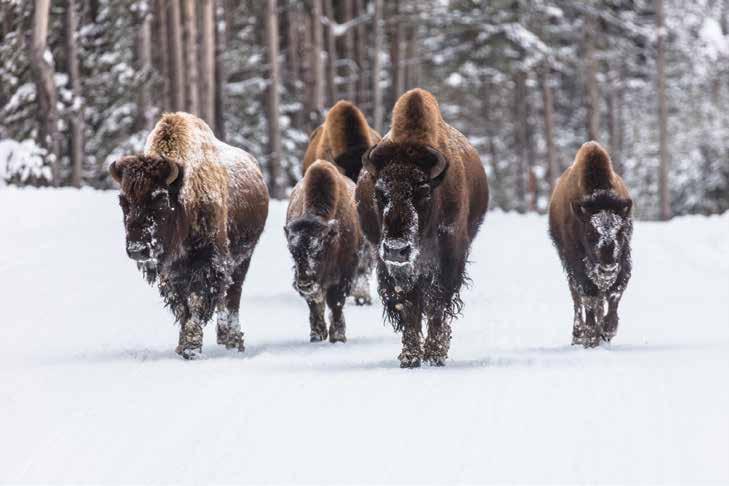
The more famous hot springs are to the east in Pagosa Springs. But Durango Hot Springs Resort + Spa has made improvements in recent years to definitively set itself on the soaking map. Make reservations to enjoy 16 toasty pools with a view.
All aboard
Durango & Silverton Narrow Gauge Railroad rewards passengers with scenes of the San Juan Mountains that can’t be had any other way. Winter rides explore a different realm, one perhaps even more magical.
That’s the five-hour trip to Cascade Canyon. The 52-mile journey is a dreamy tour among snow-draped rocks and forests, arriving to an unforgettable destination for lunch. You’ll have an hour to take photos and walk along the river.
That’s not the only option. The Polar Express experience is complete with lights, hot chocolate, elves and Santa himself. Advanced reservations are recommended.
Southern Colorado’s San Luis Valley is known for a wide range of surprises, from sand dunes and geothermal springs to a campground dedicated to aliens and a park dedicated to alligators.
Another surprise is Zapata Falls, in easy reach of Great Sand Dunes National Park & Preserve. The 25-foot cascade streaks down a rocky crevasse, a cool enclave that feels a world away from the park but is only about 6 miles from the visitor center. A washboard road switchbacks a short, rumbling way to a trailhead near 9,000 feet. On foot, it’s another short, steep way to the creek that’s fed by the waterfall. The cavernous destination is upstream, where begins another short challenge. We visited when the water was frozen, requiring careful steps while gripping the slick, canyon wall.
It’s a scenic return on the trail through juniper. One now faces out to the valley, through the trees glimpsing the 14,000-foot
mountains that sharply rise above the dunes, including Crestone and Kit Carson peaks.
The view is best from the parking lot. Locals know this as the best place to catch the sunset, watching the colors glow across the big land and sky. Conveniently, there’s a campground nearby.
Trip log: 0.9 miles round trip, 237 feet elevation gain, 9,252 feet max
Difficulty: Easy-moderate
Getting there: Going south on Interstate 25, take exit in Walsenburg for U.S. 160 and go west. Turn right on Colorado 150 toward Great Sand Dunes National Park & Preserve. Turn for Zapata Falls in about 101/2 miles. Follow road up for 31/2 miles to trailhead.
FYI: Hiking only. Dogs on leash. More information on Zapata Falls Campground at blm.gov/visit/zapata-falls-campground
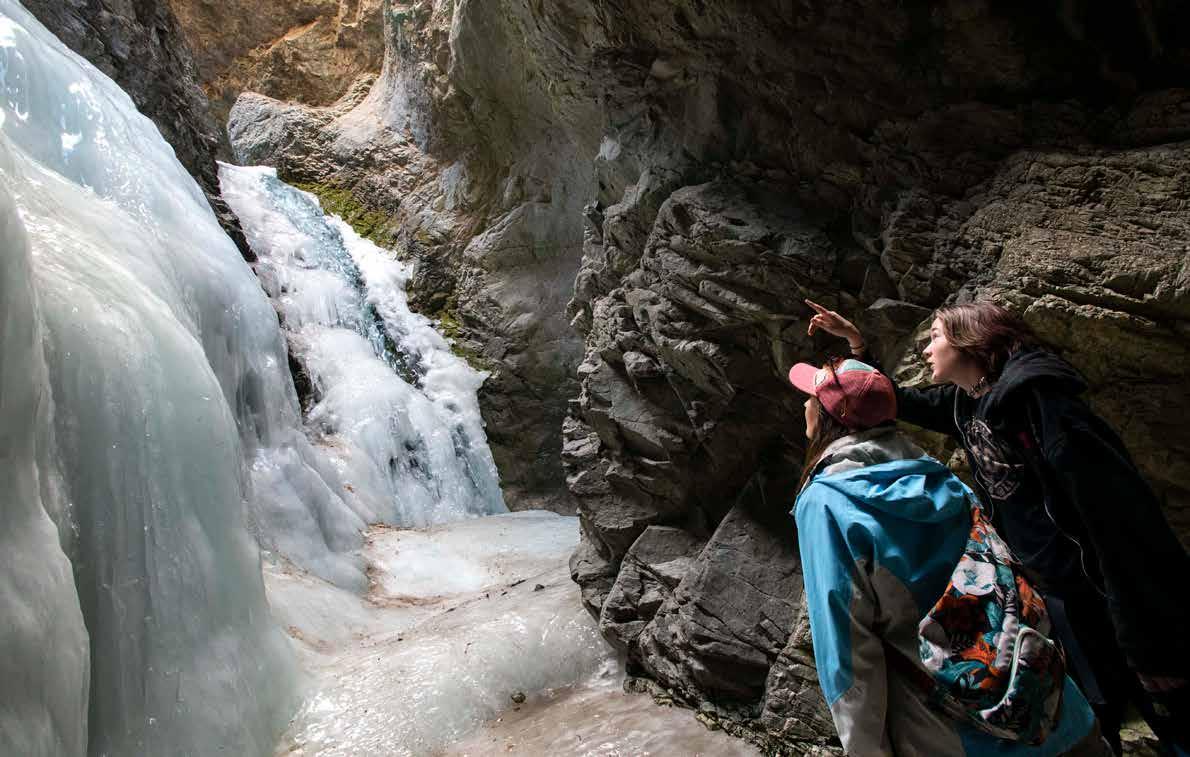
While they roar in spring and summer, there is something no less wondrous about Colorado’s waterfalls when they freeze. Take in the winter silence while admiring Mother Nature’s great sculptures.
Bridal Veil Falls
Spanning as high as 365 feet in a box canyon overlooking Telluride, these are considered the state’s tallest cascades. You can hike to the icy base via a trail covering about 21/2 miles round trip.
Elk Falls
You’ll have to earn this 75-foot waterfall, the grand prize of Staunton State Park west of Conifer. The round trip is 12 miles from the main parking lot or 8 miles from the new Lazy V parking lot.
Fish Creek Falls
A snowy forest is the backdrop for this 283-foot slab outside Steamboat Springs. A short, paved path leads to an overlook. Another short, dirt trail leads to the base. A longer trek includes a second waterfall.
Horsetooth Falls
Near Fort Collins, a popular canyon is adorned by pearly white, jagged sheets and slender columns. These are the rewards along a 3-mile loop accessed from Horsetooth Mountain Open Space.
Rifle Falls State Park
In western Colorado, Rifle Mountain Park becomes a photo-worthy series of ice caves. The nearby state park adds another destination. There are more quiet caverns to explore behind this triple waterfall. Seven Falls
The Broadmoor-owned spectacle is a holiday classic in Colorado Springs. Visitors follow a staircase beside the frozen pillars aglow in color. It’s heralded “The Grandest Mile of Scenery in Colorado.”
SETH BOSTER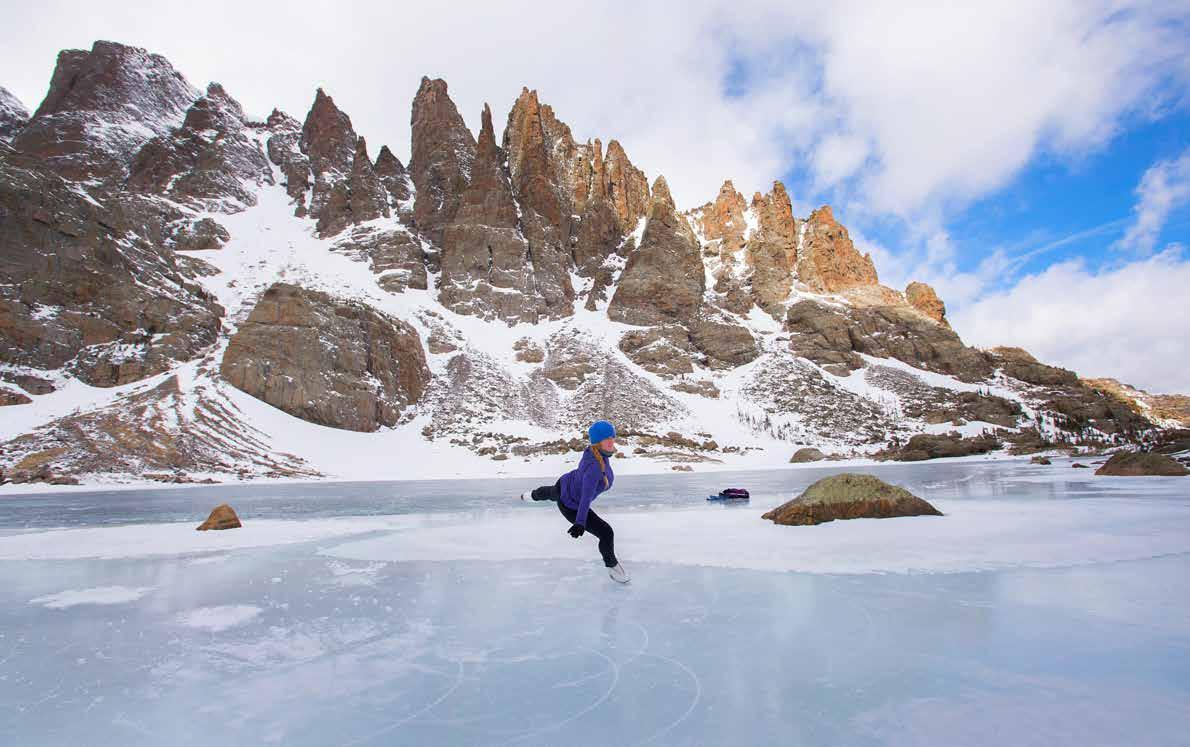 By Seth Boster
By Seth Boster
Colorado’s alpine lakes require extra fortitude in the winter. Snow poses a challenge to the hiker, while avalanches and hypothermia are other risks that must be weighed. However bitter the cold, it all makes success even sweeter. Here are six lakes to consider:
State Forest State Park is often called “little Rocky Mountain National Park.” Though, it’s Colorado’s biggest state park at 71,000 acres, boasting views of the Never Summer and Medicine Bow ranges. The Nokhu Crags deliver more eye candy on the way to Agnes. The winter route is about 21/2 miles and 1,000 feet.
The summer demand for one of the state’s most iconic natural landmarks has led to advanced reservations and shuttles. Locals around Glenwood Springs know the best time to go is the tourist offseason. They strap on the Yaktrax and ascend the steep, mile-plus trail in rare solitude.
This is one destination from the popular Hessie trailhead near Nederland. The trail serves as a portal to Indian Peaks Wilderness, an embarrassment of riches with its meadows, streams and craggy sentinels. Structures of mining days await on the 41/2-mile round-trip journey to the lake near 9,800 feet.
Some around Aspen prefer winter to visit this cherished landmark. Though, they must work for the view of the lake beneath the regal, snow-streaked Maroon Bells. Maroon Creek Road is closed to vehicles in the snowy months, making it 12.4 miles round trip by cross-country skis, snowshoes, fat bike or snowmobile.
From Rocky Mountain National Park’s Glacier Gorge trailhead, the nearly 5-mile trek can be perilous. Explorers are known to carefully climb a snowfield beside Timberline Falls, rising to a lake often mistaken as Sky Pond. From there, the route isn’t exactly defined to Sky Pond, with glassy water framed by promontories.
One of Denverites’ favorite day trips feels a little more epic in the winter. Hopefully, it’s a little less busy too. Driving west on Interstate 70, take exit 238 for Fall River Road and follow about 8 miles to the parking lot. It’s only a half-mile walk to St. Mary’s Lake, surrounded by powder-packed, Rocky Mountain majesty.
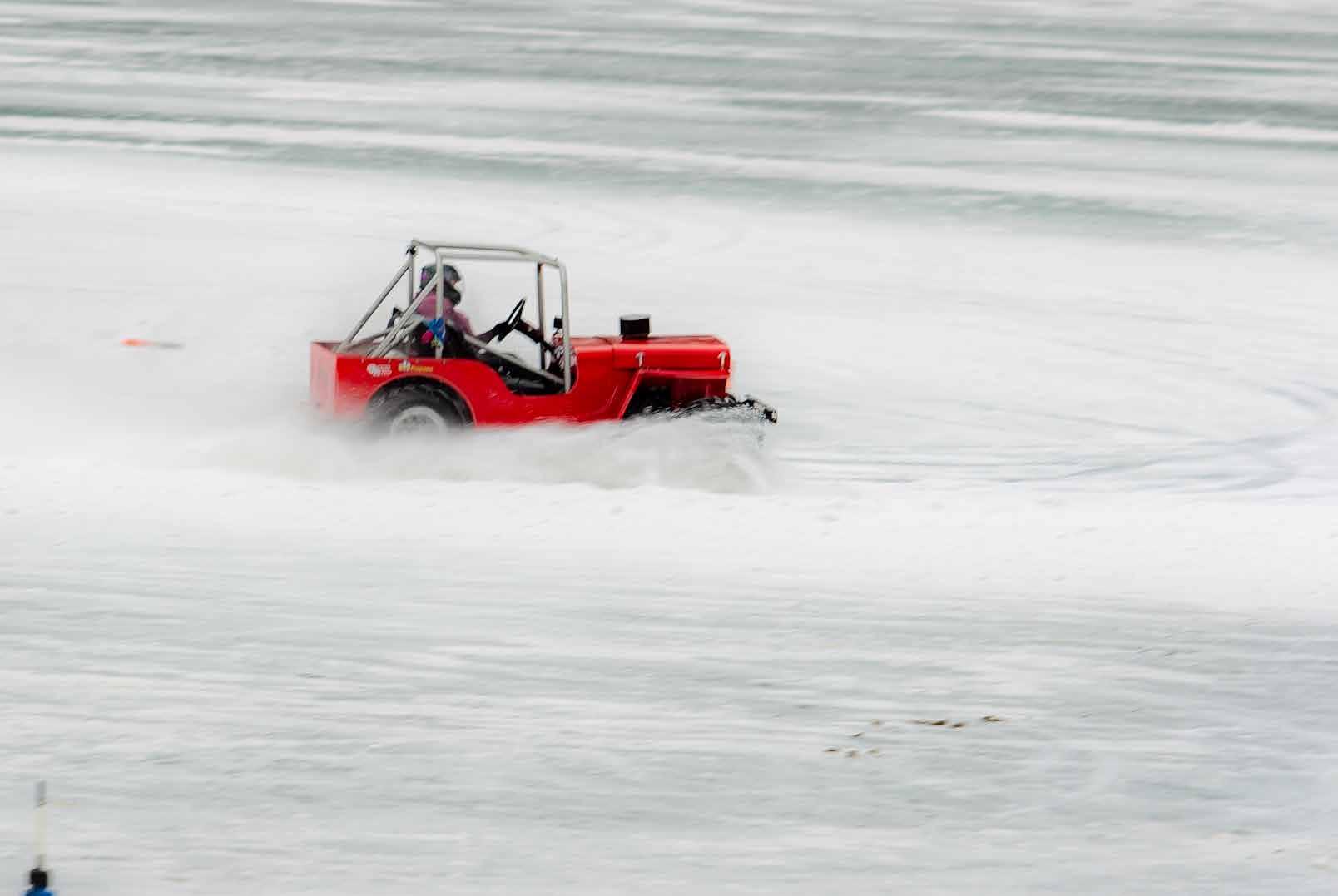
In 2011, Donny Cryer traveled to Colorado from his home in Texas for what he thought would be a long vacation of skiing.
He ended up falling in love with another winter sport rooted in these mountains.
Now living in Silverthorne, Cryer finds himself at the helm of a niche tradition on Georgetown Lake. He’s president of Our Gang 4 Wheelers, the club that for decades has rallied dragsters, trucks and souped-up rigs for good, old-fashioned ice racing.
Moto enthusiasts know what’s up. As for unknowing skiers en route to their destinations on Interstate 70, they’ve seen close to 100 vehicles parked on the frozen lake and exited to see what it’s all about.
“They’re just kind of amused and questioning,” Cryer says. “They’re like, ‘What in the world are you guys doing?’”
For as many as six weekends typically in January and February — when the ice is at least a foot thick and considered fit to hold hundreds of thousands of pounds — they’re competitively zipping and swerving as they’ve done for a long time. Our Gang’s inaugural season was 1977. But the sport in Colorado traces its origins to the 1960s.
“It all started when a group of guys got together and decided to try driving on a frozen pond above Central City,” reads the history on Our Gang’s website.
They went on to call themselves the Rat Patrol. They
specially built machines called Super Jeep, Red Baron, Quiksilver and Green Latrine. From that pond in Central City, they set their sights on bigger venues, including Twin Lakes near Leadville.
“They just decided to give this a go,” Cryer says. “They went out and just kind of started doing it, and they started inviting people.”
Our Gang’s annual series is a draw for many familiar with racing on asphalt and dirt. “There are people who see it and immediately want to try it,” Cryer says.
They’ll have to pre-register. They’ll have to pass a vehicle inspection. They’ll have to pick a class: ones for bare rubber and ones for studded, gripped tires. Then they’ll have to learn the tricky ways of ice.
It’s not as much about speed — 40 mph is uncommon on Georgetown Lake — as it is about careful, calculated handling on the courses, Cryer says.
“Basically, if you’re on ice, you need to be able to turn,” he says.
“If” has increasingly been the question in recent years. Our Gang canceled all races last winter due to unstable ice conditions. Cryer says that’s been a highly unusual move in the club’s long history.
So for last winter’s eager drivers, anticipation could be as high as ever.
“You can only do it two months out of the year,” Cryer says. “If it happens, you do it while you can.”
A ghost town in the middle of nowhere. That’s how people described Ouray during winters of the 1980s.
Nestled in a remote box canyon of southwest Colorado, “some mornings there wasn’t a single car on Main Street, no human form stirring in the frosty air,” according to an account written by Peter Shelton.
“Then a remarkable and unlikely thing happened. People started coming to Ouray to climb man-made frozen waterfalls.”
The story goes a mountaineer by the name of Bobo peered into the dark depths of the Uncompahgre River Gorge just up Main Street. He spotted a blueish, towering slab of ice spilling from a leaky pipe. More of these were found across the old infrastructure — perfect for axes and crampons, a renegade crew discovered.
Ouray Ice Park.
Christian Murdock
Ouray Ice Park is Colorado’s premier hub for ice climbing. Here are five other sporty arenas for beginners and seasoned alpinists alike:

Clear Creek Canyon
Water freezes over the rock walls to form both steep and steady-rising routes. Golden Mountain Guides leads outings tailored to all experience levels.
Eleven Mile Canyon
Colorado Springs-based Front Range Climbing Co. has managed
a private, intimate venue within this river-fed canyon of Park County. The man-made curtain is well-suited for newcomers.
Lake City Ice Park
Though on a smaller scale than Ouray, Lake City has been similarly committed to creating an attraction with varying pitch-
Thus began a grassroots mission to farm ice and create a climbing venue unlike anything in all of North America. In the coldest hours of the night, spray heads would be turned on, and the routes would form over the vertical crag.
Ouray Ice Festival is set for Jan. 19-22. For details, check ourayicepark.com.
Thus Ouray Ice Park was born — along with one of the sport’s premier events worldwide.
January will mark the 28th annual Ouray Ice Festival, an ultimate celebration of climbing and the venue that awakened the town from its winter slumber.
“The Ouray Ice Park is to Ouray what the ski hill is to Telluride,” said Peter O’Neil, executive director of the nonprofit running the free park. “Now (Ouray) is healthy and vibrant, and visitation is through the roof.”
Every year thousands of climbers journey to this pocket of the San Juan Mountains, this so-called “Switzerland of America.” For the festival, they come for the competition and the camaraderie of evening seminars, films, happy hours and parties. It’s a festive and scenic atmosphere that also appeals to non-climbers, who might join a clinic to test gear or simply spectate.
The show is slated to be bigger and better this winter.
If all goes accordingly, ice makers will have more water to work with than ever in the park’s history. That’s after an agreement to pump water from the creek, rather than rely on dwindling supply from the city tank. Curtains and daggers are set to span farther across the gorge, as are the walkways for access.
Climbers “can expect more routes, fatter ice and hopefully less crowding, because we’ll have more terrain to spread climbers throughout the park,” O’Neil said.
And so the 28th Ouray Ice Festival won’t only be a celebration of the past and present. It’ll be a celebration of the future.
es — and similarly committed to expanding, having added a second wall in recent years.
Rigid Designator Amphitheater
This limestone zone of the Vail Valley is not for the faint of heart. The rare, alpine bowl is laden with overhangs and daggers that have imposing names.
Rocky Mountain National Park
The state’s crown jewel is a climber’s playground come winter. Top-rope beginners flock to 75-foot Hidden Falls. Kent Mountain Adventure Center and Colorado Mountain School are trusted outfitters nearby.
SETH BOSTERA few winters ago on the frozen shore of Dillon Reservoir, Dan Burnett was surprised to meet a sailing allstar, Buddy Melges, whom Burnett learned was on a family skiing trip in Summit County.

Burnett was even more surprised by the following interaction. The visiting legend had just watched the local fly across the ice in the extremely niche act of ice boating. “He said, ‘Could I take your boat out for a quick ride?’” Burnett recalls.
No was the answer.
“I mean, how obnoxious could I be? It was like telling Mario Andretti he couldn’t drive your car!” Burnett says. “But it makes the point: You don’t lend out your ice boat because it could smash into bits, and the person will get killed, and that would not be good.”
Such is the risk Burnett has run for decades on Dillon Reservoir, along with a few other lifelong, retirement-age sailors who know no offseason.
The large body of water under the gaze of the Gore Range turns solid, and on perfect afternoons, the wind blows just right for a thrill unlike anything else — unlike even the famed skiing steeps surrounding them.
With a slender hull sitting atop three metal runners or “skates,” ice boats can soar three to four times the speed of the wind. For the small group on Dillon Reservoir, 80 mph is not uncommon.
They’re happy with modest breezes; 10 mph is enough to send them cruising near 40 mph. They need thick ice, of course; anyone doing it long enough has a story of falling in due to sudden, undetected fragile spots. They prefer some snow to give them some foot-propelled traction for pushing off. But too much snow means too much friction and little to no speed.
“Clearly,” Burnett says, “ice boating is for people who want to scare the heck out of themselves.”
But the spectacle is not often witnessed in Colorado.
The sport is more popular in the Midwest and along the East Coast, regions that have the benefit of more water. Still, enthusiasts there, like enthusiasts here, count on those just-right conditions, similarly tricky to achieve.
At Dillon Reservoir, the fickleness of it all means Burnett and his fellow ice boaters might get anywhere from three days to three weeks on the ice every year. When the opportunity presents itself — the thick ice, the ideal wind, the limited snow — one calls the other, who calls the other and so on.
Optimal ice boating was realized after 1937, when The Detroit News sponsored a homebuilding contest. That resulted in a design that remains the global standard today: simply known as the DN, with a hull 12 feet long and 21 inches wide, a 16-foot mast and a runner plank stretching 8 feet across.
Among people willing to put in the time and money without getting much use, DNs are still fashioned in garages today. But one does not simply break into ice boating, veterans warn.
Considerable knowledge and skill is required, they say, with the consequences multiplied on ice. A slight incorrect maneuver at high speed could topple the vessel and fling the one steering the front skate with one hand, the sail with the other.
“Because of the intensity of the situation, the nature just feels really beautiful,” Burnett says. “All of the colors, all of the sounds, all of the things you experience in nature intensify. The crystals shining in the sun, the snowflakes, the beauty of the ice, the mountains, the sound of the ice groaning underneath you. It’s all very intense.
“And that’s an addicting thing. You want your senses to be tuned up full blast.”
EVERGREEN • Anyone who’s lived here long enough has sweet memories of the lake.
Sweet, like the drink John Ellis remembers. It was concocted in the old warming hut, that log cabin still standing along the shores that freeze for an ice skating tradition dating to 1928, when the dam was finished.
“Like Dr. Pepper, but you made it yourself,” says Ellis, the white-bearded town Santa who was born in a barn around these hills west of Denver in 1947. “Coke and cherry and 7 Up, and we mixed them all together.”
Pam Lindquist remembers that warming hut. “The cigarette smoke and smell of wet wool socks,” she says.
She remembers those nights after school, skating until someone’s parents arrived for pick-up. Her parents skated before her, among neighbors in their ties and wool skirts.
Now, rather than the hut, the meeting place is a building big enough for weddings and a rental shop. Now, it’s not uncommon for a couple of thousand to skate the lake on busy days, managers say. Locals and the growing masses of Denver converge at what is billed as North America’s largest groomed outdoor rink.
Heart Cameron does the grooming from the driver’s seat of a Zamboni he equipped with a Volkswagen engine.
“It’s as real as ice skating gets I think,” Cameron says. “You’ve got the mountains, the trees. It’s so classic, romantic. It’s how it used to be, the real deal.”
While nostalgic for some, it’s all too representative of Colorado’s changing recreation landscape for others.
The lake is still the town “centerpiece,” says Kendra Head, who grew up skating here and now works for Evergreen Park and Recreation District. But the lake is not quite what it used to be, she says. It’s not always easy to park. As lots fill, shuttles ferry visitors from off-site.
“It’s kind of heartbreaking in a way because we’ve lost that smalltown feel,” Head says.
But pride in the landmark remains. Look no further than Cameron, the dreadlocked man with Native blood and a name bestowed upon him in a sweat lodge. He considers it an honor to tend to the “soul” of town — that’s why he’s been doing it for the better part of twoplus decades.
“It’s a big thing for us,” Cameron says.
At a lake this size, there’s room for everyone, Ellis says. He still finds some of the old joy from his memories. Still finds inspiration from the views and the sunrises and sunsets.
“You can’t go too wrong,” he says.
For decades, ice skating at Evergreen Lake has been an iconic way to experience Colorado winter. Here are some other outdoor venues around the state:

Colorado Springs
One side of downtown’s Acacia Park is transformed for skating in what’s been a years-long holiday tradition. Santa is known to make occasional appearances during the festive season, typically starting in November.
Denver
It’s always a memorable skate
at Skyline Park along 16th Street Mall. If the holidays have your family traveling, arrive extra early for your departure for some laps on the rink at Denver International Airport.
Gunnison
The modest town in western Colorado has its very own slice of winter wonderland. That’s
Jorgensen Ice Rink and Events
Center, which includes indoor and outdoor rinks alongside miles of Nordic trails.
Idaho Springs
The Frozen Fire Rink is a newer winter addition to the old mining town off Interstate 70. Digger Field has been the scene for rosy-cheeked families, who have
warmed up with rink-side hot chocolate and s’mores.
Keystone Resort
It’s not only the world-class slopes that are maintained here. The Summit County resort also runs a Zamboni over a rink that’s on par with Evergreen Lake. So bring the skis and the skates.
SETH BOSTERIn the foothills west of Denver, ice skating tradition is belovedEvergreen Lake. Courtesy
It wasn’t many winters ago that Robby Richardson would venture to Antero Reservoir, one of his favorite ice fishing spots, and see no one.
“You wouldn’t see another person there for weeks,” he recalled. “Now it’s like everyone’s racing to see who the first one will be to get there. And they post it on social media, and the next thing you know there’s 50 people out there.”
Welcome to fishing’s ice age.
Colorado Parks and Wildlife has reported selling more sporting licenses in recent years, and it’s easy to see more people are casting lines beyond summer and fall. Based in Gunnison, Richardson has expanded his guiding service to be a branch of its own: Ice Fish Colorado.
“Ice fishing has really grown to become our prime time,” he said.
Richardson credits the boom partly to that trend on social media. The sport is simply catching more eyes.
It’s a credit as well, he said, to the development of gear. Shelters are getting warmer and more affordable, while he sees gadgets such as sonars and cameras — allowing anglers to spot fish in real time — as also increasing the appeal.
But you don’t need the latest and greatest stuff, longtime enthusiast Chris Spaulding said.
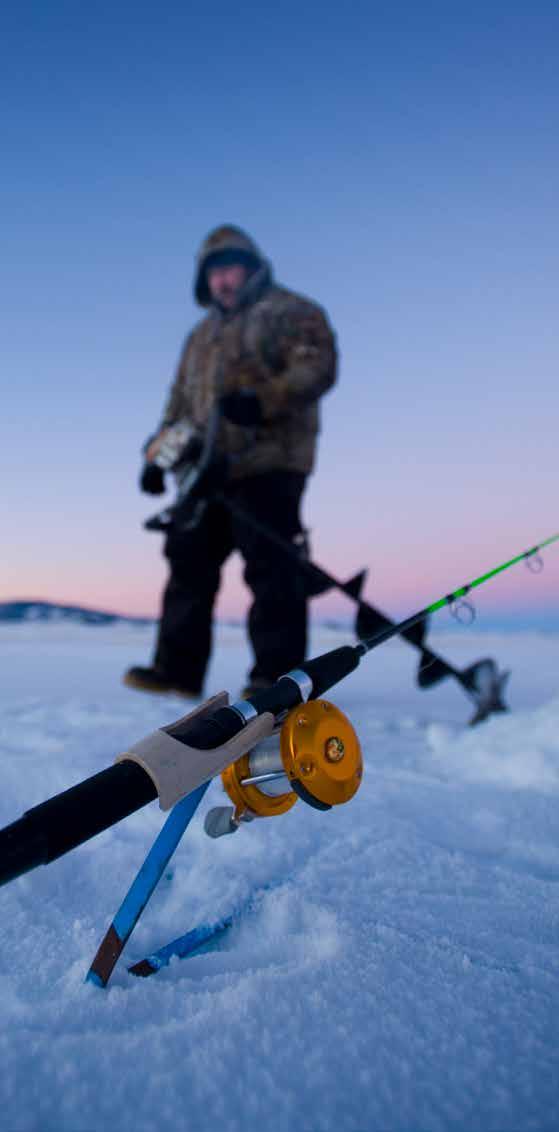
If you’re going ice fishing for the first time, take it from Colorado Parks and Wildlife: “There probably is no such thing as ‘safe’ ice, but there are some guidelines anglers should consider.”
The agency lists those guidelines on its website, including how to judge ice and what equipment to bring. Check that out before considering these six places to drop your line:
• Antero Reservoir: Thanks to South Park’s frigid temperatures, Front Range enthusiasts look to these 2,500 surface acres to “break the ice” in the early season. The scenic Buffalo Peaks provide the backdrop.
• Blue Mesa Reservoir: On Colorado’s biggest body of water, anglers depend on the eastern end to ice over first. Their shelters march on from there as the season gives way for chances to catch lake trout and kokanee salmon.
• Eleven Mile Reservoir: This 3,400-acre reservoir shares the cold territory with Antero. The reservoir is indeed a challenge, says Robby Richardson of Ice Fish Colorado: “It can make you feel like you don’t know anything about fishing in a hurry.”
A rod, bait, auger, bucket and simple safety tools will do, he said.
Assuming you’ve got a coat, hat, gloves and other warm layers, “you put about $100 into it, you’re gonna be ice fishing,” said Spaulding, who runs Colorado Tackle Pro in Colorado Springs.
For decades, the experience has been priceless to him.
“There’s something about the cold, crisp morning and that fresh mountain air,” he said.
There’s something about the silent solitude if he goes alone and something about the camaraderie if he goes with friends. Something about the hours of peering over a hole and seeing the fish drift below — “like fishing in an aquarium,” Spaulding said. Something, too, about how the fish bite in winter.
“Typically you have better chances for bigger fish in ice fishing,” Spaulding said. “At the beginning of winter, when the ice is first forming, there’s still a lot of oxygen in the water and the fish really start feeding quite heavily.”
In ice fishing, “the playing field is more even,” he said. This was something Richardson noted when he started as a kid.
“You could be an everyday angler and have minimal equipment, and you could get anywhere on the lake as if you were a guy with a boat,” he said.
• Lake Granby: North of Winter Park, this is a destination known for ice fishing tournaments. Along with classic rainbow trout and whopping mackinaw, Colorado’s second largest lake offers stunning views of the Indian Peaks.
• Skaguay Reservoir: East of the old mining camp of Victor and under the towering gaze of Pikes Peak, Skaguay is teeming with trout and huge northern pike.
• Tarryall Reservoir: Tucked by the remote border of Lost Creek Wilderness, this is a good, early-season bet. “It’s got plenty of fish that are not hard to figure out,” said Chris Spaulding, who runs Colorado Tackle Pro in Colorado Springs.
SETH BOSTER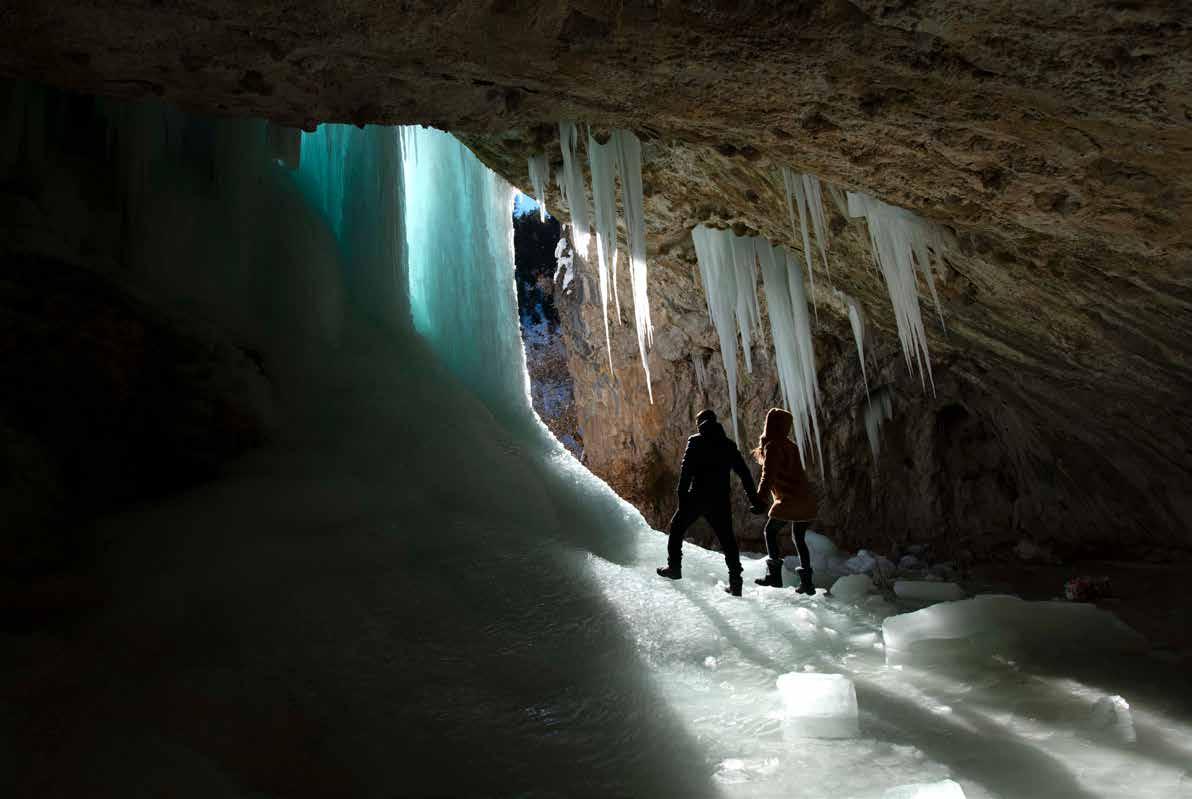
It’s not a drive that people soon forget, that drive from the little western Colorado town of Rifle to the place where the landscape suddenly, drastically alters. From the turn at the bowling alley to the place where the road turns to dirt, it’s only about 14 miles.
“I remember the first time I drove through that canyon,” says Tom Whitmore, Rifle resident since 1984. “It was like, ‘What in the world? This is unbelievable!’”
Even more unbelievable in winter, when Rifle Mountain Park transforms into something that wasn’t so widely known when Whitmore first visited. Now there are reviews scattered across the internet.
“Indescribable,” one writes of the ice caves.
“Magical,” reports another.
“A fantasy land,” reads another.
Another calls this “winter’s best kept secret,” which is not true.
Just ask Whitmore, Rifle’s parks and recreation director who oversees the mountain park. People are flocking to the ice caves like never before, he says. He gets it.
“It’s just a rare thing and easily accessible,” he says. “I took my kids up there a lot. It was the first chance they had to see something like that.”
Frozen, bluish curtains drape limestone overhangs, creating caverns that feel out of this world, adorned with towering columns and icicles.
A trail visits four of these glossy realms, which go by the names of Ice Palace, Stone Tree, Soul on Ice and Final Curtain. One walks or crawls into the caves, which are silent but perhaps for water dripping and trickling.
It’s water to thank for the creation, water that runs over these canyon walls and freezes en route to the creek. Cycles of freezing and thawing contribute to a scene that is ever evolving.
In her book recounting a long life in the area, “Rifle Vignettes,” Betty Clifford paints the picture of that watercress growing deep in winter. “Have you seen it this winter?” she writes of Rifle Mountain Park, as if imploring one to go. “Every time I go up the creek, I am overwhelmed by its beauty ...”
Going up the creek, Clifford writes, is a tradition as old as Rifle. Where tribes hunted, fished and gathered berries, homesteaders sprouted around the canyon, settling where they marveled at the steep, narrow walls crowned by evergreens.
The federal government went on to roll out a program that gave municipalities opportunities to buy land. The arrangement that afforded the city of Denver the likes of what is now Red Rocks Amphitheatre similarly afforded the city of Rifle the property that is now Rifle Mountain Park.
“Shocked” is how Whitmore describes people who witness the scene.
“And if they’re lucky, they go when there’s not many people around,” he says. “And they say, ‘Wow, what a hidden gem, we need to promote this more!’ And other people say, ‘No, don’t!’”
Come winter, tourists and residents alike will flock to Colorado’s mountains in search of adventure. Not everyone is interested in hitting the ski hill, however. This scenic road trip features several things to do along Interstate 70 — none of which requires a pricey lift ticket. Just be sure to bring a camera, and pack some patience if you’re driving during peak travel times.
On your way out of Denver, make a quick pit stop at J.C.’s Cafe in Golden to fuel up for an incredible day. This popular spot opens at 5:30 a.m., serving up all of the breakfast classics you’d expect.
While many travelers stop at Indian Hot Springs in Idaho Springs for the rest and relaxation of heated pools, don’t forget about the spa. Visitors are offered several relaxing options, including a cupping massage, heated rock therapy and a CBD massage. There’s also a mud-soaking experience on-site.

Want to feel on top of the world? A drive from I-70 to the summit of Loveland Pass is a convenient way to catch some stunning views of snowcapped peaks from nearly 12,000 feet.
One of several family activities offered at Frisco Adventure Park is snow tubing. Blast down this slick Summit County venue on an inflatable tube. A variety of lanes offers a variety of experiences.
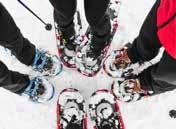

Located just off I-70 near the summit of Vail Pass, Corral Creek Trail is a popular spot for snowshoers. Out and back, it’s about 5.5 miles, boasting stunning views and a vertical gain of more than 1,000 feet.
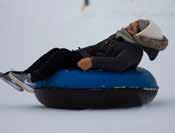
Head to Vail Square Ice Rink in Lionshead Village to glide across the ice while surrounded by a picturesque mountain town scene. Don’t forget to check out some of the town’s charming shops and eateries.

Looking for a rush? Stop at Beaver Creek Snowmobiling Tours and Rentals for guided and unguided snowmobiling tours through Eagle County.
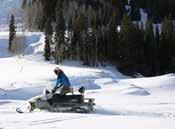
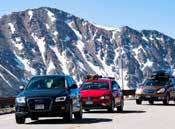
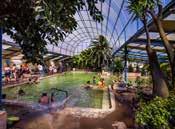
Colorado is home to many geothermal locales. One of the better stops is found along the Colorado River in Glenwood Springs. Not only does this relaxing scene feature a mountain view, it’s also a great place to watch a sunset.
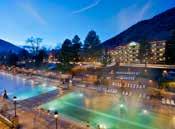

The ice caves of Rifle Mountain Park, situated roughly 30 minutes outside Rifle, feature an enchanting experience unlike any other. This spot offers a stunning photo opportunity.

Once you reach Grand Junction, cap the day at Colorado National Monument. While this desert destination remains very hot most of the year, it cools down significantly during winter. It’s a great time to take advantage of a less extreme desert atmosphere while still enjoying incredible views.
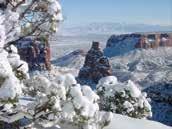
The summertime powder hound will take any sign of hope. For example: mushrooms.
Said Colorado skiing’s trusted weather man Joel Gratz: “People have come to me and said, ‘When it’s been a really rainy summer and the mushrooms are great, the ensuing winter is really good, right? Is that true?’”
Not exactly, Gratz is sorry to report. OpenSnow’s founding meteorologist can cut historic data in several ways — some wet and mushroom-filled summers were followed by snowy winters, others not so much. The whims of Mother Nature are many and ever unpredictable.
To forecast her ways months in advance is “pretty tough,” Gratz said. “And by tough, I mean somewhat absurd.”
But in the months leading up to winter, she does drop hints. Look not to the mushrooms, but to El Niño and La Niña.
And, specifically for this winter, look to La Niña.
Another pattern of cooling across parts of the Pacific Ocean is projected for the season. This would be a third straight year for the pattern — a rare “triple dip” that OpenSnow reports as having happened twice since 1950.
What does that mean for skiing in the West?
“During La Niña seasons, the best correlation with more snowfall is in the northwest,” Gratz said. “So Montana, Wyoming, northern Idaho, Washington, British Columbia. (The)
Colorado correlation is not as strong.”
That, he said, is due to the state geographically falling in a “tricky” spot for north- and south-trending storms. He characterized the past two winters under La Niña as a mixed bag across Colorado’s slopes — “some good parts, some bad,” he said.
Snow was below average last winter, “but if you hit it at the best times, you might’ve felt like we had a great season,” Gratz said. That’s if you hit it when storms favorably trended, though briefly. That speaks to atmospheric variability, the way the wind blows.
“Some of this does come down to what meteorologists call internal variability,” Gratz said, “or we can just say dumb luck.”
OpenSnow’s historic analysis provides hope.
“[W]hen clusters of two or more La Niña winters have occurred, at least one of the winters ended up being a ‘big winter’ across a large portion of the West,” read a report approaching fall. “While there is no scientific reasoning for this, if history is any indication, then the odds of ’22-’23 being a good winter are decent.”
Gratz’s advice is simple.
“The secret to getting the most powder days is going out as often as you can,” he said. “If you’re out there, you have a chance to catch it.”
It’s no secret that Colorado is home to wild weather. From hailstorms to blizzards, it’s crucial for residents to be in the know. Here are four great spots to find a Colorado weather forecast:
1. OpenSnow — For an in-depth forecast with details specific to ski country, be sure to check out OpenSnow.com. The Colorado Daily Snow report, powered by meteorologist Joel Gratz, is one resource that shouldn’t be missed by the winter adventurer.

2. Mountain Forecast — For a helpful look at how weather varies by peak and elevation, go to Mountain-Forecast.com. Never leave to climb a mountain without checking the site first, no matter the conditions at the trailhead.
3. Colorado Avalanche Information Center — While the CAIC (avalanche.state.co.us) provides a different kind of forecast, it’s one to be aware of if venturing into the backcountry. The avalanche risk forecast shows travelers how dangerous various regions of the state are.
4. National Weather Service — Visit the NWS website (weather.gov) for the most up-to-date information regarding official weather alerts and predictions.
SPENCER MCKEEArapahoe Basin: October
Keystone: October
Loveland: October
Breckenridge: Nov. 11
Vail: Nov. 11
Copper Mountain: Nov. 14
Winter Park: Mid-November
Eldora: Nov. 18
Purgatory: Nov. 19
Beaver Creek: Nov. 23
Crested Butte: Nov. 23
Steamboat: Nov. 23
Aspen Mountain: Nov. 24
Snowmass: Nov. 24

Telluride: Nov. 24
Howelsen Hill: Nov. 26
Echo Mountain: November
Cooper: Dec. 7
Sunlight: Dec. 9
Aspen Highlands: Dec. 10
Granby Ranch: Dec. 10
Buttermilk: Dec. 17
Silverton: Dec. 29
Hesperus: December
Powderhorn: December
Monarch Mountain: TBA
Wolf Creek: TBA
Note: Dates are subject to change, pending conditions. Check ski areas’ websites for official information.
Claim to fame: A-Basin is known as “The Legend.” That’s partly due to its long season — known for more operating days than any other ski area in Colorado, typically opening first in North America and sometimes staying open through Independence Day. More so, the nickname is rooted in history. This was the first post-World War II ski area to open in the state.
Skiable terrain: 1,428 acres Trails: 147 Lifts: 9
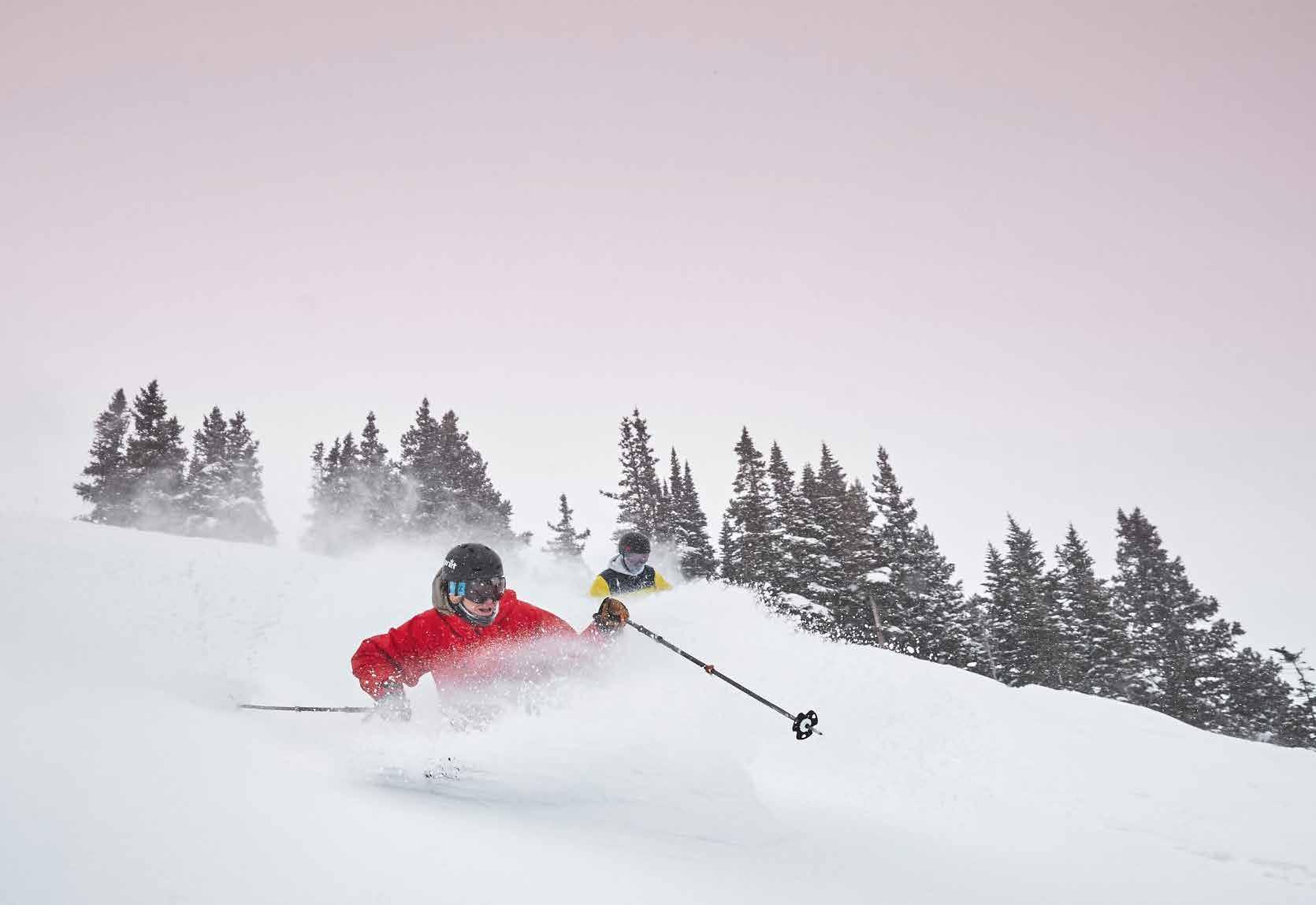
Mountain stats: 13,050-foot summit, 10,520-foot base
Check out: Near 12,500 feet, Il Rifugio is considered the highest dining option in Colorado ski country. 6th Alley Bar & Grill is the base hub pouring a lot of Bloody Marys for patrons on the scenic deck.
Claim to fame: Locals claim Highlands as their territory, and even the most expert among them can be humbled. Double black diamond runs coat the majority of the mountain. Most heralded is Highland Bowl, reached on foot, which speaks to the independent character of the ski area. In writing on Highlands’ “maverick” roots, historian John Moore dug up a story about a former, resident shepherd who lit a coyote on fire.
Skiable terrain: 1,040 acres Trails: 144 Lifts: 5
Mountain stats: Highland Bowl at 12,392 feet, 8,040-foot base
Check out: Cloud Nine Alpine Bistro is a fixture on the mountain. Regulars return to the cozy cabin for fondue, apple strudel and wine.
Claim to fame: It’s also known as Ajax. Other locals know it as “the mothership” — the one that put this old mining town on the map. Aspen Mountain was the first development of the four ski areas now trumpeted by Aspen Skiing Co. It was a dream of Walter Paepcke in the 1940s and remains a dream today for regulars who regard it as something of a backcountry outpost.
Skiable terrain: 675 acres Trails: 76 Lifts: 8
Mountain stats: 11,211-foot summit, 7,945-foot base
Check out: Customers crave the truffle fries at Ajax Tavern, situated at the mountain’s base.
Claim to fame: The resort off Interstate 70 features an apres-packed village at its center plus mountainside gourmet meals reached via sleigh ride. Though seeming posh, there’s a bigger club of gritty vert seekers who fit right in at Beaver Creek. The commitment to novices is exemplified by zones such as McCoy Park, a 250-acre expanse of gentle slopes in a high-alpine setting.
Skiable terrain: 2,082 acres Trails: 167 Lifts: 24
Mountain stats: 11,440-foot summit, 8,100-foot base
Check out: Blue Moose Pizza has been a favorite since 1995, tossing New Yorkstyle pies in an unpretentious setting.
Claim to fame: Colorado’s biggest gold nugget was unearthed in Breckenridge. Now one of ski culture’s greatest gems is found here. A pair of Norwegian racers-turned-instructors are to thank for the resort we know today. Some of the more beloved terrain remains across Peak 8, where the founders started. Breck consists of five peaks named 6 through 10.
Skiable terrain: 2,908 acres Trails: 187 Lifts: 35
Mountain stats: 12,998-foot summit, 9,600-foot base
Check out: Everyone knows the whiskey, of course, but locals swear by the food at Breckenridge Distillery. The menu was envisioned by an internationally renowned chef.
Claim to fame: While the steeper the better for patrons of Highlands and Ajax, Buttermilk was designed for beginners. Still, the mountain pumps plenty of adrenaline. The smallest of Aspen’s ski areas is home to the X Games. Skiers and snowboarders can test their skills across the jumps and rails at several terrain parks.
Skiable terrain: 470 acres Trails: 44 Lifts: 5
Mountain stats: 9,900-foot summit, 7,870-foot base
Check out: You can count on Home Team BBQ, with a comfort food menu born in the South.
Claim to fame: However modest in size, Cooper might be the boldest representation of Colorado’s pure skiing spirit. It can be called the birthplace of the industry as we know it. During World War II, this is where 10th Mountain Division soldiers trained on skis in preparation for travel in the Alps. They went on to establish the likes of Vail.
Skiable terrain: 480 acres Trails: 64 Lifts: 5
Mountain stats: 11,700-foot summit, 10,500-foot base
Check out: No trip to Leadville is complete without a step inside historic Silver Dollar Saloon.
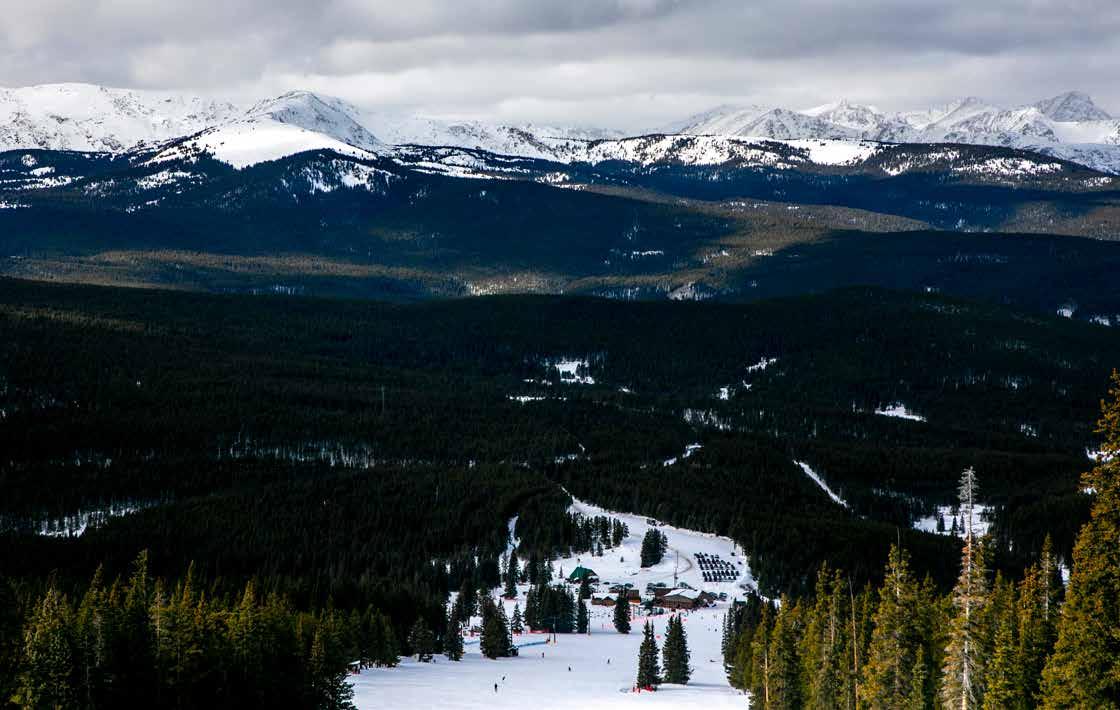
Claim to fame: In separating itself from the other ski areas in Summit County, Copper Mountain touts its geographic arrangement. Beginners typically cluster in the West Village, where the ski and ride school is based. The East Village is made up mostly of black runs and is also home to the U.S. Ski Team Speed Center.
Skiable terrain: 2,507 acres Trails: 150 Lifts: 24
Mountain stats: 12,313-foot summit, 9,712-foot base
Check out: If you’re an IPA lover, you probably already know about Frisco’s Outer Range Brewing Co. If not, you should.
Claim to fame: Crested Butte has liked to call itself “the last great ski town.” It still likes to call itself that in the years after the resort went corporate under Vail Resorts. The remoteness, the steepness, the historic charm of the town down the road — it’s all unchanged. And, yes, some hippies continue the end-of-season tradition of scantily clad skiing.
Skiable terrain: 1,547 acres Trails: 121 Lifts: 15
Mountain stats: 12,162-foot summit, 9,375-foot base
Check out: The secret to crushing those steeps all day? Coffee and doughnuts at Camp 4.
Claim to fame: Located less than an hour from downtown Denver, between Evergreen and Idaho Springs on Colorado 103, this ski area has lived many lives. Overseers are counting on this one to be the fullest. One attempt at standing out: night skiing. Visitors can lap a couple of runs lined by lights. The terrain isn’t much — but neither is the price compared with the rest of ski country.
Skiable terrain: 60 acres Trails: 9 Lifts: 3
Mountain stats: 10,650-foot summit, 10,050-foot base
Check out: In Idaho Springs, Beau Jo’s calls itself the original home of “Colorado-style” pizza.
Claim to fame: About a half-hour drive west of Boulder, the ski area has worked to capitalize on its proximity to Front Range populations. It’s worked to satisfy a variety of skill levels too. The six-person, high-speed Alpenglow Express opened in 2017, granting guests quick turns and big vert. Don’t be intimidated: Eldora prides itself for being “THE place to learn in Colorado.”
Skiable terrain: 680 acres Trails: 53 Lifts: 12
Mountain stats: 10,600-foot summit, 9,360-foot base
Check out: Kids and adults alike are transported by the Carousel of Happiness in the heart of Nederland.
Claim to fame: It continues as a year-round destination, complete with golfing, mountain biking and fly-fishing. But with new ownership comes a new vision for winter. Previously, the website promised: “Everything about Ski Granby Ranch is EASY.” It now promises this: “Granby Ranch will never lose its intimacy, but it ain’t no mom and pop.” The multimillion-dollar vision includes enhanced snowmaking.
Skiable terrain: 406 acres Trails: 40 Lifts: 5
Mountain stats: 9,202-foot summit, 8,202-foot base
Check out: Mid Town Cafe calls its pastries “mouthwatering temptations to start your day off right.”
HESPERUS
Claim to fame: Hesperus derives from the term in Greek mythology meaning “evening star.” And it’s in the evening when the ski area shines. The lights come on, and locals after work come to get their turns. The hill has a rare all-volunteer ski patrol.
Skiable terrain: 60 acres Trails: 26 Lifts: 1
Mountain stats: 8,888-foot summit, 8,100-foot base
Check out: You’ll feel as if you’re part of a night-time secret with a cocktail at speakeasy The Bookcase & Barber in Durango.
Claim to fame: Nothing proclaims Steamboat Springs as Ski Town USA like the local hill. It’s steeped in 100-plus years of history — the longest-going history of any ski area in the West. No such complex in North America compares with these jumps. Since its establishment under Norwegian immigrant Carl Howelsen, almost 90 Olympians have made the area their training ground.
Skiable terrain: 50 acres Trails: 17 Lifts: 4
Mountain stats: 7,136-foot summit, 6,696-foot base
Check out: For skiing on the opposite end of the spectrum, Rabbit Ears Pass is a popular backcountry spot.
Claim to fame: It was a family affair in the 1950s — the passion project of two couples, Bill and Jane Bergman and Max and Edna Dercum. Now, their development is beloved by the skiing world. Keystone is the biggest of Summit County’s four ski destinations. The founders’ names are on the resort’s two prominent features: Bergman Bowl and Dercum Mountain.
Skiable terrain: 3,149 acres Trails: 130 Lifts: 20
Mountain stats: 12,408-foot summit, 9,280-foot base
Check out: Near the center of the resort, Snake River Saloon & Steakhouse promises to fill you up with hearty plates.
Claim to fame: Chester “Chet” Upham headlined the latest class of the Colorado Snowsports Hall of Fame. For more than 50 years, he was president of the state’s longest-operating, privately owned ski area. Loveland aims to honor him by maintaining its rootsy qualities.
Skiable terrain: 1,800 acres Trails: 94 Lifts: 11
Mountain stats: 13,010-foot summit, 10,800-foot base
Check out: Suds for all at Tommyknocker Brewery in Idaho Springs.
Claim to fame: High on the pass west of Salida, the ski area is without the glitz and glamour of resorts to the north that march on with development. Monarch, meanwhile, appears trapped in time. And ownership plans to keep it that way. Even modern luxuries such as snowmaking are resisted. The hope is you’ll feel the difference on all-natural powder.
Skiable terrain: 800 acres Trails: 67 Lifts: 7
Mountain stats: 11,952-foot summit, 10,790-foot base
Check out: In Salida, Sweetie’s Sandwich Shop has perfected lunch and dessert.
Claim to fame: Grand Junction is defined by desert terrain prime for mountain biking. Yet for five decades on the edge of the Grand Mesa, Powderhorn has satiated the craving for snow. Despite being the ski area on the flanks of the world’s largest flattop mountain, the place is often overlooked. That’s fine by locals, who’d prefer to keep the glades and moguls all to themselves.
Skiable terrain: 1,600 acres Trails: 63 Lifts: 4
Mountain stats: 9,850-foot summit, 8,200-foot base
Check out: Tacoparty in Grand Junction is a hip take on Mexican.
Claim to fame: If the name doesn’t sound familiar, you might recall it formerly as Durango Mountain Resort. Despite the ominous title, it’s all smiles at Village Plaza, a scene of family activity, lodging and dining. And it’s all smiles on the mountain, which isn’t quite as crowded as many resorts.
Skiable terrain: 1,635 acres Trails: 105 Lifts: 11
Mountain stats: 10,822-foot summit, 8,793-foot base
Check out: Oscar’s Cafe is a longtime staple for breakfast.
Claim to fame: “Steep and deep” is the motto at this ski area that is unlike any in Colorado. Few in North America can compare with the operation that features heli-skiing — dropping from a helicopter onto powder-packed slopes. You won’t find groomers across this daunting, secluded swath of the San Juan Mountains, festooned with rocks, cliffs, bowls and chutes.
Skiable terrain: 1,819 acres, with 22,000 additional acres for heli-skiing and hike-to terrain Lifts: 1
Mountain stats: 13,487-foot summit, 10,400-foot base
Check out: Kendall Mountain Ski Area, in walking distance of town, is a cheap, family favorite.

Claim to fame: America’s growing ski industry turned its collective attention to Aspen in 1967, when Snowmass-at-Aspen sold its first tickets for $6.50. At the time, it was seen as the nation’s grandest enterprise of its kind. Snowmass carries on the reputation. Beyond winter attractions such as Hanging Valley and Cirque, the resort has grown with summer attractions such as an alpine coaster and canopy tour.
Skiable terrain: 3,339 acres Trails: 94 Lifts: 16
Mountain stats: 12,510-foot summit, 8,104-foot base
Check out: For the “other side of Aspen,” check out Woody Creek Tavern, a former haunt of Hunter S. Thompson.
Claim to fame: Skiing is almost as fundamental as walking in Steamboat Springs. So it’s no surprise the ski resort is one of the largest in Colorado. And maybe it’s no surprise that nearly half the terrain across Steamboat’s six peaks has an advanced designation. Still, families find plenty of fun here, basking in the glory of “champagne powder.”
Skiable terrain: 2,965 acres Trails: 170 Lifts: 17
Mountain stats: 10,568-foot summit, 6,900-foot base
Check out: Western attire and more at F.M. Light & Sons will have you looking like a ranching local.
Claim to fame: The sell at Sunlight is skiing by day, soaking by night in Glenwood Springs’ thermal waters. With 75% of the trails for beginner and intermediate skill sets, Sunlight is known as a family-friendly retreat. For double black diamond runs, seek the East Ridge. Also, Sunlight offers miles of groomed trails for cross-country skiing and snowshoeing.
Skiable terrain: 730 acres Trails: 72 Lifts: 3
Mountain stats: 9,895-foot summit, 7,885-foot base
Check out: Doughnuts and hot breakfast sandwiches at Sweet Coloradough.
Claim to fame: It’s hard to be objective when ranking ski resorts. But this is the aim of Z Ranking, which outlines a data-based approach culminating in a score called “the pure awesomeness factor.” In Colorado, Telluride takes the experts’ top spot. They start their case with this: “Visually, Telluride is the most striking ski town in North America.”
Skiable terrain: 2,000-plus acres Trails: 148 Lifts: 17

Mountain stats: 13,150-foot summit, 8,725-foot base
Check out: Breakfast and lunch at Baked in Telluride.
Claim to fame: In all of North America, Vail is behind only Whistler Blackcomb, Big Sky Resort and Powder Mountain in terms of skiable terrain. Shuttles and heated walkways connect the resort’s three sections: Front-Side, Blue Sky Basin and Back Bowl. All have achieved legendary status for their range of challenges and views.
Skiable terrain: 5,317 acres Trails: 195 Lifts: 31
Mountain stats: 11,570-foot summit, 8,120-foot base
Check out: Gourmet dinner and drinks at Sweet Basil.
Claim to fame: What began as a project by Denver government to provide winter fun for residents has become a major destination for skiers and riders from everywhere. The famously bumpy terrain is spread across two mountains, with the majority of beginner trails found on the resort’s namesake peak. The Mary Jane side caters more to the advanced types, with plenty of technical moguls and flowy blues.
Skiable terrain: 3,081 acres Trails: 166 Lifts: 23
Mountain stats: 12,060-foot summit, 9,000-foot base
Check out: Randi’s Grill & Pub warms the belly with shepherd’s pie and meatloaf.
Claim to fame: In southwest Colorado, pull off scenic Wolf Creek Pass and enter a winter wonderland of nostalgia. Locals here are spoiled with supreme powder — the most of any ski area in Colorado, say the family owners and operators. Ritualistic regulars hike to a variety of terrain.
Skiable terrain: 1,600 acres Trails: 77 Lifts: 10
Mountain stats: 11,904-foot summit, 10,300-foot base
Check out: Pagosa Springs is Colorado’s hot springs capital, fueled by the Mother Spring, believed to be the world’s deepest geothermal spring.
 By Seth Boster
By Seth Boster
Colorado is a mecca for skiing. Summit County is the mecca within the mecca.
The mountainous locale off Interstate 70 is saturated with four world-renowned destinations: Arapahoe Basin, Breckenridge, Copper Mountain and Keystone. The flavors vary. And, as in any good candy store, they can be hard to choose.
Here’s what to know:
A-Basin is dedicated to a throwback dream, a time before parking hassles and long lift lines. That dedication was exemplified by the ski area abandoning Vail Resorts’ Epic Pass a few years back. Despite economic gains from pass holders, the traffic was deemed too great.
Evidently, A-Basin is banking on its reputation.
Famed for annually opening before any other operation in North America and keeping its lifts turning into June, the ski area is simply “The Legend.” That’s thanks to elevations starting at 10,500 feet and capping above 13,000 feet. Call it a big little mountain — the steeps and views visitors long for across acreage much smaller than its Summit County counterparts.
The East Wall calls to the experienced, high-alpine seekers. Montezuma Bowl is another extreme, breathtaking playground of chutes and bumps. The glades and gullies under the Pallavicini lift attain equal hype. Beginner and intermediate types opt for the Molly Hogan learning area and terrain below Black Mountain Express.
Everyone ends at the base’s 6th Alley Bar & Grill. Regulars know that nothing beats a Bacon Bloody Mary after a hard day on the hill.
Summit County’s three other ski destinations can’t claim a town like Breckenridge Resort. There’s something to be said about starting and ending a day along Main Street, where mining history lives and a certain sense of place prevails in old watering holes and upscale eateries.
It’s the place for C.J. Mueller. He broke speed records in a Hall of Fame career. Nowadays, he catches the mellow runs. There’s a family run on Peak 8, Springmeier. “I really enjoy that,” he told us a couple of seasons ago.
Peak 8 is one of the five peaks that make up Breck. It’s the terrain smorgasbord you’d expect of that size. Peaks 6 and 7 are defined by long, rolling cruisers. The longest run is on Peak 8: the 31/2-mile Four O’clock Trail. That peak boasts the expert paradise of Horseshoe Bowl as well. More alpine glory on Peak 10.
To refuel later, will it be casual or fancy? For casual, Mueller suggests Fatty’s Pizzeria or Empire Burger. For apres: “I like the Hearthstone. The one thing I tell people you got to have there is the jalapeño-stuffed shrimp,” he says. “The Briar Rose, their creamed spinach is awesome, and their crème brûlée is the way it should be.”
Copper Mountain differentiates itself for its convenient layout. A beginner’s guide on the website calls the resort “the perfect place to build your skills.”
Beginners start at West Village, “and the terrain increases in difficulty level as you move east,” the guide explains, “so you won’t have to worry about getting mixed in with the experts.”
East Village, on the other hand, is the seasonal home of the U.S. Ski Team. Olympic hopefuls train on steep, tree-lined groomers near that base, which accesses powder-packed bowls called Resolution and Spaulding.
Center Village, meanwhile, offers blue terrain between the blacks and greens. Later in the season, from the Mountain Chief lift, explorers can board a snowcat to the highest, most extreme terrain on Tucker Mountain.
Non-skiers will find something fun around the resort. There’s a snowy “play zone” and tubing hill, along with a snow maze and alpine coaster. That’s not to mention all of the shopping and dining. Most of the bars and restaurants are clustered in Center Village.

Covering 3,149 acres, this is the biggest of Summit County’s ski areas. While Breckenridge is Vail Resorts’ answer to the late season, this is the company’s answer to the early season. State-of-theart snowmaking aims to kick off the season as soon as possible in October.
Hundreds of guests received free burritos at last year’s opening day. The rewards go beyond that.
Before it was a pride and joy of Vail Resorts, Keystone was the vision of a pair of local couples. Their names remain on Dercum Mountain and Bergman Bowl. Some lap the green and blue runs on the former, while fewer like to earn their turns by skinning up the latter — including the ski patrol director, Mike Daly. The Outback, the resort’s highest reaches, has been another must-hike for him when conditions are right.
“When you get in a storm cycle, the place is incredible because people don’t want to hike that much at Keystone,” he previously told us. “So you’ll be getting fresh turns every time for a short 10- to 15-minute hike.”
Later, he might catch music and a hearty meal at Snake River Saloon.
A guide to Summit County’s world-famous ski areas
A ski run is an adrenaline rush. It’s a mellow cruise. An easy way to catch a view. A peaceful commune with nature. A ski run is a lot of things. It’s history, too. See what’s behind some of the unique names:
Tom’s Baby: Breckenridge’s hard-charging regulars know about this one, shooting fast down Peak 9. It’s named for miner Tom Groves and his record. It’s said he wrapped his 131/2-pound gold nugget in a blanket and carried it around town like a precious newborn.
CJ’s: This run flows steep and straight from high on Peak 7, fitting for the man who broke speed records on skis in the 1980s. C.J. “Crazy John” Mueller still resides in Breckenridge and skis regularly. Though, lately, he’s been just fine frequenting the greens and blues.
Wild Irishman: This is but one Keystone trail named for surrounding mines that popped up during the silver rush. Wild
Irishman’s manager was Terrence Connors, who had a saying: “You never heard an ass bray when he had grass.”
Baldy’s Chute: This double black diamond at Winter Park is just how Jim Baldwin would’ve liked it. As previously reported by Colorado Public Radio, he was a beloved member of the ski patrol in the 1970s before he died doing what he loved at a nearby glacier.
Janitors Only: When the previously out-ofbounds terrain entered the Steep Gullies expansion in 2017, Arapahoe Basin longtimers could appreciate it. In the 1980s, the Atomic Janitors skied all day on the mountain, cleaned at night, slept in an A-frame and did it all again the next day.
Wapiti, Dead Spike and Bull Run: At Purgatory, these runs are named for elk. Wapiti is a Native American word for the animal. Spike is the word for a young elk; one was found dead during construction. Another was seen running during another job.
Naked Lady: Hal Hartman was the man assigned to trails in Aspen Snowmass’ first years. He was boss to the mischievous son of the sheriff. The kid tacked a wide-open Playboy magazine to a tree one day. The magazine was removed, but the name stuck.
Riva Ridge: Vail has the 10th Mountain Division to thank for its creation — the World War II-era soldiers who trained on skis at nearby Camp Hale. One of the unit’s great achievements came on Riva Ridge in the mountains of northern Italy.

Zip, Zippity Split, Zip Basin Street: These trails at Loveland seem to suggest gravity’s pull. But actually they’re a nod to the Zipfelberger Ski Club, some of the ski area’s early regulars.
Cow’s Face: Vail founder Pete Seibert named this run after a description he heard from a maintenance man at Loveland. The man found some slopes “steeper than a cow’s face, and her a-grazin’.”
Last winter, Rick Noll got a call from a man on a mission to hit every ski area in Colorado.
Noll, the city of Ouray’s resource director, recalled the question: “What’s the lowdown on Lee’s Ski Hill?”
It’s not often Noll receives outside inquiries about the neighborhood slope, complete with a rope tow originally put together with old mining stuff after the land was donated in 1946.
Noll was more than happy to answer the caller. The way he sees it, Lee’s is part of a legacy often lost on today’s masses bound for nearby Telluride or similar sprawling destinations. While the likes of Vail rose in the 1960s and 1970s, hills such as Lee’s remained in the shadows.
And so they remain today — municipal-run spots that time seemingly forgot. They are hills that look more apt for sledding and are therefore ignored and mocked by resort-goers. They are, however, cherished by families living around them.
“They are invaluable breeding grounds for skiing,” said Melanie Mills, president and CEO of trade association Colorado Ski Country USA. “And we need as many of them around as we can possibly keep operating.”
Depending on how you define them, there might be a half-dozen in Colorado.
The scene is similar at them: Kids getting out of school and walking straight over. Noll has watched from atop Lee’s in Ouray. Such hills “are all part of the world-class ski reputation Colorado has,” he said. “It’s just that people don’t know it.”
There is the oldest and most famous of them in the state: Howelsen Hill. Since 1915, the hill has given Steamboat Springs its Olympian-producing reputation.
There is, in Silverton, Kendall Mountain Recreation Area. The lodge hosts holiday gatherings, and Fridays traditionally feel like a potluck — parents grilling while kids ring in the weekend with turns across five runs.
Also in the southwest, there is Durango’s Chapman Hill. It maintains a World War II-era rope tow used by skiing soldiers of Leadville’s 10th Mountain Division.
There is Gunnison’s Cranor Hill, which the town’s parks and recreation director likes to say is run by intrepid, jump-building kids. “You wouldn’t see that at Breckenridge, kids out there with a shovel doing what they want,” Dan Vollendorf says.

And there is Lake City Ski Hill, which in recent years has displayed a fitting message online: “Schuss ... schuss ... schuss ... At other ski areas, that is the sound of money being sucked from your wallet.” Here, it’s the sound of carving skiers who pay $15$25 for a pass, rental equipment included if around.
For whatever these places lack in acreage and vertical, there is no shortage of something “intangible,” as Adrienne Saia Isaac puts it.
“That intangible piece of skiing that’s difficult to articulate,” said the Colorado-based spokeswoman for National Ski Areas Association, “but you know it when you feel it, and it feels like you’re in the soul of the sport.”
There’s no denying Grand Lake in the summer. With the boardwalks connecting charming shops and eateries, and with the state’s largest natural body of water only steps away, the town in Colorado’s central mountains feels something like a beach getaway.
But in the cold of winter, Grand Lake shines no less. The quaint hamlet often is missed in the shadow of Winter Park Resort, that world-famous ski destination to the south. There’s no

chairlift in Grand Lake, but there’s no shortage of powder-packed adventure. There’s not the abundance of apres sit-downs, but you shouldn’t have a problem finding a fire to cozy up to with your favorite drink.
And you’ll find something else here that busy resorts can’t quite claim. There’s a quiet that prevails. A certain kind of serenity. A sense of calm and appreciation afforded by a true, authentic escape in the wintertime Rockies.
Grand Lake is the western portal of Rocky Mountain National Park. This side of the park doesn’t draw the crowds of the other side, via Estes Park. And the solitude is felt even more so in the winter.
Rent a pair of snowshoes or cross-country skis and see the majesty for yourself. Or check in with Kaiyote Tours and allow experts to show you around; they know the spots for moose viewing.
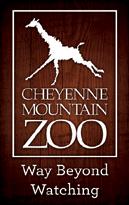
Grand Lake Nordic Center maintains trails for snowshoeing through glistening forests and along the Colorado River, where you might eye a bald eagle. The center also grooms a 35-kilometer circuit for skiing. Kids will love the hill for sledding and tubing. When you’re done, settle down with a bowl of chili. Grand Lake is a base camp for ice fishing. Enthusiasts dot the frozen water in town as well as Shadow Mountain Reservoir and Lake Granby nearby.
In recent years, a free ice skating rink has been set up at Town Park along Grand Avenue.
Grand Lake is committed to its self-proclaimed title: the Snowmobiling Capital of Colorado. That’s a commitment exemplified by
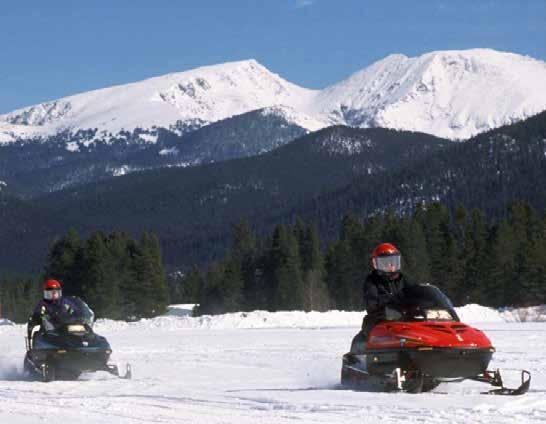
the town maintaining snowpacked roads so riders can conveniently pass through and park where they please.
But the boardwalk is not their destination. Local ambassadors count 300-plus miles of snowmobile trails in the vicinity, with about half of those groomed. The surrounding Arapaho National Forest serves as a vast playground. Allow guides with On the Trail Rentals or Grand Adventures to show you around scenic meadows, forests and ridges.
The past is always present around Grand Lake. Buildings still stand from the town’s early days, including the elaborate Kauffman House. The 1892 home now houses a museum. It’s been open for tours on select dates over the winter.
The riverside Rapids Lodge & Restaurant is another historic landmark. It’s a cozy, romantic stop for an evening cocktail.
If not there, consider dinner at Sagebrush BBQ & Grill, with buckets of peanuts, gamey sausages and platters of smoked meats in an old West setting.
You’ll have to come back in the summer for a show at Rocky Mountain Repertory Theatre. Still, the creative town reveals itself at several artist-owned galleries.
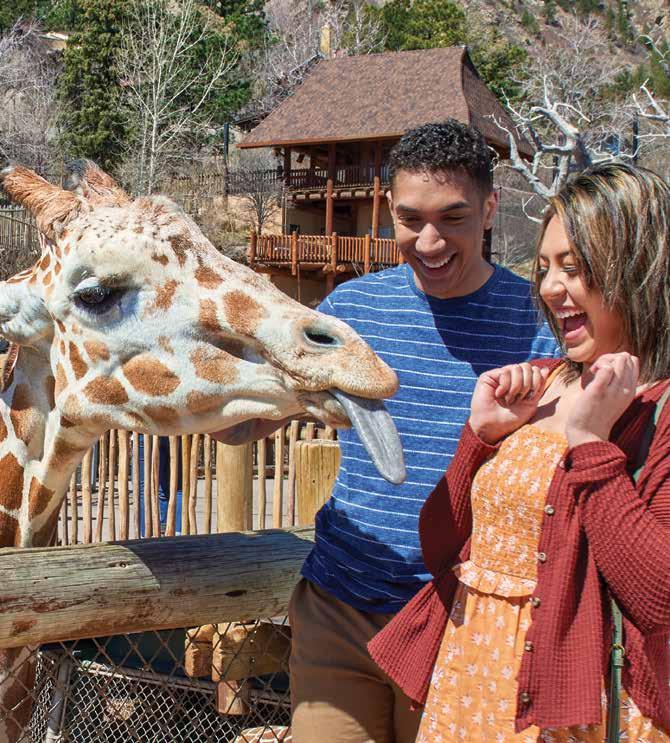
Nov. 12: Pikes Peak Hospice & Palliative Care’s Trees of Life Tree Lighting — A celebration in memory of thousands of loved ones and a tribute to the military and first responders, Colorado Springs Pioneers Museum
Nov. 12: Eagle Winter Market & Holiday Fair — Vendors, kids’ activities and more, Eagle River Center, Eagle
Nov. 18-Dec. 31: Santa Express Train and Holiday Rides — Royal Gorge Route Railroad, Cañon City
Nov. 18-Jan. 1: The Polar Express Train Ride — Durango & Silverton Narrow Gauge Railroad, Durango

Nov. 18-Jan. 7: Blossoms of Light — A twinkling winter wonderland, Denver Botanic Gardens
Nov. 23-Dec. 28: Miracle at Union Station — A whimsical pop-up cocktail bar with Christmas spirit, Union Station, Denver
Nov. 25-27: Victorian Christmas Tea — 10:30 a.m., 12:30 p.m. and 2:30 p.m., Miramont Castle, Manitou Springs
Nov. 25-27: Victorian Christmas Tours — 10 a.m.-3:30 p.m., Miramont Castle, Manitou Springs
Nov. 25-Jan. 1: Trail of Light — A winding path glistening with lights that illuminate the Colorado countryside, Chatfield Farms, Littleton
Nov. 25-Jan. 1: Luminova Holidays — Dazzling lights, candy cane tunnel, rides and more, Elitch Gardens, Denver
Nov. 26-Jan. 1: Holiday Headframe Lighting — Headframes of mining days will light up the sky with holiday ornaments and more, Victor and Cripple Creek
Dec. 2-4: Fire Festival — Interactive experience of fire artistry, Telluride
Dec. 2-4, Dec. 9-23, Dec. 25-Jan. 1: Electric Safari — Cheyenne Mountain Zoo, Colorado Springs
Dec. 3: Festival of Lights Parade — Downtown Colorado Springs
Dec. 3: Lighting of Breckenridge and Race of the Santas — With 250,000 LED holiday lights, Breckenridge
Dec. 8-11: ULLR Fest — Celebration of all things winter and snow, Breckenridge
Dec. 9-11: Winterfest — Santa, ice skating, marketplace and more, Carpenter Park Fields, Thornton
By Carlotta OlsonDec. 10: Jingle Jog 5K — 9 a.m., Fountain Creek Regional Park, Fountain
Jan. 12-15: Wintersköl Celebration — Annual toast to winter in the heart of the Rockies, Aspen
Jan. 15-16: Women’s Big Mountain Camp — An adventurous weekend for experienced female skiers and snowboarders, Silverton Mountain
Jan. 19-22: Ice Festival — Presentations by climbers, music, food and more, Ouray
Jan. 21-22: Skis and Saddles Skijoring — A horse and rider pull a skier through an obstacle course of jumps, gates and rings, Pagosa Springs
Jan. 27-29: UllrGrass — Music, beer fest, vendors and more, Golden
Jan. 27-29: Rio Frio Ice Fest — Featuring the Rio Frio 5K on ice, Alamosa
Jan. 27-29: X Games Aspen — Action sports and music festival, Buttermilk Mountain, Aspen
Jan. 27-Feb. 1: Budweiser International Snow Sculpture Championships — Breckenridge
Jan. 28: Winter Brew Fest — Music, vendors and more, Mile High Station, Denver
Feb. 1-5: Snowdown — Parade of Lights, beer dunks and more, Durango
Feb. 2-5: High Plains Snow Goose Festival — Tours, speakers and more, Lamar
Feb. 4: Wine and Chocolate Festival — Estes Park
Feb. 8-12: Winter Carnival — Snow sculpting, ski jumping and more, Steamboat Springs
Feb. 17-19: Midwinter Bluegrass Festival — Featuring Blue Highway, Possum
Trot Bluegrass and more, Denver
March 3-5: WinterWonderGrass — Music, brews and mountains, Steamboat Springs
March 3-5: Ski Joring & Crystal Carnival — Horse and rider will pull a skier through a course with gates, jumps and rings, Leadville
March 4: Whiskey Warm Up — A winter tradition of warming up from the inside out, Estes Park
March 10-12: Monte Vista Crane Festival — Watch thousands of sandhill cranes, ducks and geese fly against a mountainous backdrop, Monte Vista
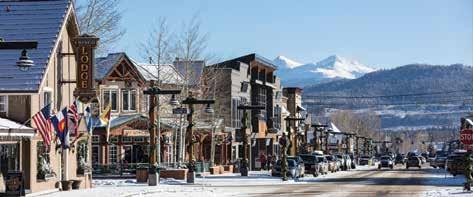

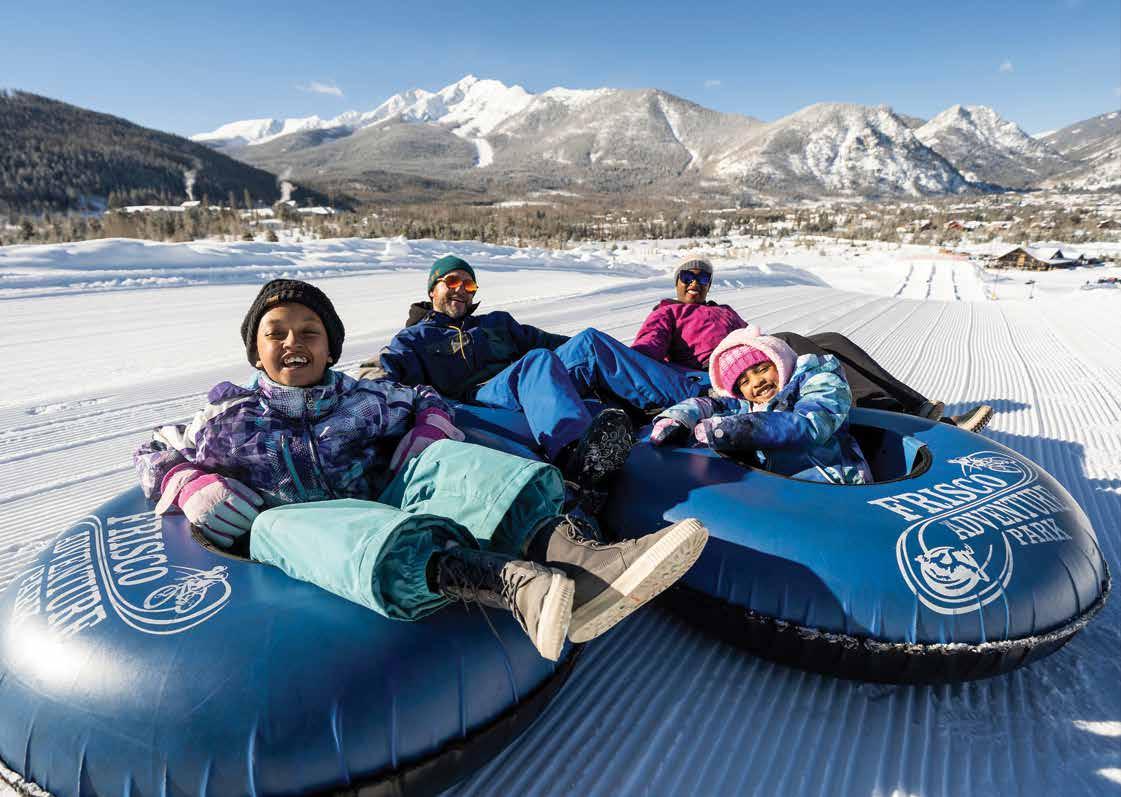
Wherever she was on her travels, and whenever she was asked where she was from, Teresa Crush-Warren would reply “Nederland, Colorado.” And always she got the follow-up question:
“Isn’t that where they found the frozen dead guy?”
Yes, word of the frozen dead guy had reached far beyond Nederland. Which got Crush-Warren thinking about her goal to boost off-season tourism in the idyllic hamlet west of Boulder. This was around 2002.
“We wanted a winter festival,” Crush-Warren recalled. They got one all right.
The annual Frozen Dead Guy Days has come to represent Nederland for 20 years now. Here where hippies and musicians have deep roots, where Grateful Dead celebrations come often, where people continue to pay respects to the grave of a former cat mayor, tens of thousands arrive for a late-season get-together of concerts, dancing, coffin racing and frozen turkey bowling.
This year’s theme centered on the full moon. As of this writing, details had yet to be announced for the event typically taking place in early March.
From her post at the cabin-like visitor center, Crush-Warren has seen Frozen Dead Guy Days take on a life of its town. It’s best described on the festival website:
“For a town like Nederland that thrives on the colorful, offbeat and weird, Frozen Dead Guy Days is a fitting way to end the short days of winter and head into the melting snows of spring. Trygve Bauge calls it ‘cryonics’ first Mardi Gras.’”
Trygve Bauge is the grandson of the Norwegian the whole town now affectionately calls Grandpa. Upon his death in 1989, Grandpa’s actual name was Bredo Morstoel. He rests in his frigid slumber in a hilltop shed above town and continues to be packed by dry ice.
This has been the tradition since city council approved municipal code regarding “the keeping of the bodies,” the festival website explains. This, the account goes on, was after some appealing in the wake of Bauge’s deportation in the mid-1990s.
His dream of a cryonics facility never would come to be in Nederland. But his experiment on his dearly departed relative would continue.
Maybe Grandpa never will return to life. But every year, festival goers report rejuvenation of their own in his honor.
Two pandemic years without Frozen Dead Guy Days had “taken its toll on us,” the event’s co-owner, Amanda MacDonald, said ahead of the 2022 return.
“This is our chance to bring that positive energy to Nederland,” she said, “and hope the vibe goes out to the rest of the world.”

Even while she was away at college, Gretchen Burkholder always returned for the annual event rooted in her sweetest memories. She’d bring her boyfriend back home to Steamboat Springs.
“We made it through some very terrible winter roads to be here, but we never stopped,” Burkholder said. “It’s something very important to me, and it always will be.”
That’s the century-old Steamboat Springs Winter Carnival to many residents. Like Burkholder, they know how significant this five-day affair is.
Typically happening the second week in February, the Carnival is considered the longest-going winter event of its kind west of the Mississippi. It dates to 1914, just before Howelsen Hill was developed to be what it is today, Colorado’s longest-going ski area.
Before then, Steamboat Springs was built to be a ranching community. Before it was Ski Town USA, it was a place where winter only meant hard, cold days in the fields.
Ranchers started the Carnival “to take a break from their brutal day-to-day life of working in the snow,” said Burkholder, now organizing the event with the historic Steamboat Springs Winter Sports Club. “They went from working in the snow to playing in the snow.”
They were joined by the town’s growing demographic that formed around the hill. Today, generations of horseback riders pull generations of skiers down the snow-packed main street in an emblem-
atic show of the bond that was forged. That’s but one cherished tradition of the Carnival.
There are several rites and rituals, starting with the opening ceremony of royal representatives. The high school band has been one staple of the parade (the unit claimed to be the first to perform on skis after starting in the 1930s). The Lighted Man is another fixture, dating to Claudius Banks in 1936. In recent years, his son has taken up the heavy suit equipped with Roman candles, rockets and a flashing football helmet.
The Steamboat Springs Winter Carnival is set for Feb. 8-12. For details, check sswsc.org/events/ winter-carnival
The Lighted Man skis downhill among kids who race and jump throughout the week. Snow sculptures, s’mores, dance parties and massive fireworks also have been on the agenda. Attendees proudly wear buttons, another tradition almost as old as the Carnival itself. Ten thousand buttons are doled out every year, Burkholder said.

She’s joined by some 150 volunteers and staff around town who help put on the event.
“It’s our Super Bowl,” Burkholder said. “It’s a ton of work, but it’s so important to our community that we keep it going.”
With each twist of the throttle, the pack of four snowmobiles roared through the powdery forest beneath Hahn’s Peak near Steamboat Springs. I was off on an adventure to find my first fresh tracks in the backcountry.
The guide worked with Colorado Sled Rentals, a company known for offering customized tours tailored to show off the wild side of the sport. If you’ve never been on a snowmobile (aka sled), a few things will surprise you.
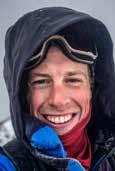

For starters, steering is a physical activity in itself; you’re not just turning a wheel for the sled to predictably follow. If you want to turn, there’s a good chance you’ll have to put your whole body into it. You might even have to stand and move to one side of the sled. After all, the sled is roughly the size and weight of a refrigerator.
Second, snowmobiles are extremely powerful. Every throttle twist has the power to send the front of the sled into the air. Instead of just stepping on the gas and maintaining a speed, it’s more about smaller precision twists that provide the perfect amount of power.
Third, there is some risk in snowmobiling, especially when you’re off trail. These machines are fast, heavy and hard to control at times.
Here’s a rundown of the terrain we encountered:
Hill climb — This required blasting up a steep slope by carefully managing weight and speed. It was stunning to see how effortlessly the machine cruised up typically inaccessible terrain. We found this type of terrain required more precision than power. Several times, one wrong twist of the throttle flipped the machine, burying it and the driver in deep powder.
Ditch banging — This involved maneuvering the sled through a powder-filled ditch. The big banks and giant pillows of snow were used to flow through the terrain in a way that felt remarkably smooth and natural. We hopped across deep snow and over terrain features with ease. Meadows — This is when we pushed the snowmobiles to their limits of speed and acceleration. With no obstacles, meadow riding allowed us to punch the throttle with much less risk, in some cases to the speed of a vehicle on a highway.
Tree sledding — During this portion of the trip, we managed our speed along a carefully plotted yet rewarding route. Now more familiar with the mechanics behind steering, we were able to guide the sleds through narrow, powder-filled gaps in the trees. Tree sledding challenges the driver to get from point A to point B, avoiding the obstacles along the way.
Cornices — As the tour came to a close, our guide was confident we could handle a few small jumps. One of the easier ways to go airborne is off a cornice. After finding a 10-foot wall of snow, we sent the sleds up and over it. The process proved simple but did require a few steps. First, it meant carefully lining up the approach to the wall. Then, upon nearing the wall, it meant giving the machine some extra throttle. Like a bucking bronco, the sled’s front end lifted in the air, and the machine launched over the snow. These jumps posed obvious risks so it’s essential to consider the danger before trying.
Bottom line: If you’re someone who enjoys an adrenaline rush and are somewhat athletic, backcountry snowmobiling is a winter adventure for you.

Come winter, Colorado has many lakes and rivers that freeze over, presenting a beautiful but potentially deadly situation. Here’s what you need to know about ice safety:

1. Ice thickness: While ice can pose a number of risks, one of the more dangerous scenarios occurs when a person falls through thin ice. Clear and solid ice must be at least 2 inches thick before it can safely support most humans. It needs to be 4 inches thick for ice fishing, 8 inches thick to support a 2-ton passenger vehicle, and 10 inches thick to support a 3.5ton truck.

2. Not all ice is equal: The Colorado Parks and Wildlife website lists six types of ice Coloradans should be able to recognize. There’s frazil ice (discs that slowly grow together), clear ice (new ice after a long freeze; generally the strongest), snow ice (milky-looking; formed by refrozen snow, low density and porous), layered ice (striped appearance; formed by frozen and refrozen snow), frazil slush (often
forms where currents are present), and pack ice (ice formation driven by wind or water currents; can have weak holes present).


3. Never go alone: It’s much safer to participate in ice-bound sports with someone watching who can potentially assist should something go wrong. It’s also important to let someone know where you’re headed and when you’ll be back.


4. If the ice breaks: Stay calm if you fall through. Attract attention to the situation, using a safety whistle if possible. Try to conserve heat by moving in a controlled manner. Try to gain traction on the edge of the ice by using your elbows and forearms while kicking your feet to push your body up and forward. Once on the ice, lay on your stomach to distribute weight more evenly and prevent additional
Just because the ground is covered with snow doesn’t mean Leave No Trace rules no longer apply. Mountain ecosystems work overtime to survive in harsh weather. With a few tweaks to summer’s best practices, however, you’ll be able to enjoy Colorado’s winter wilderness in a low-impact way.
1. Travel lightly: Winter conditions typically lead to off-trail travel. The path often becomes a series of wandering footprints so carry a GPS to stay on track. If you find yourself off-route, steer clear of stepping on young trees and vegetation.
2. When you gotta go, you gotta go: Always use the bathroom at least 200 feet from sources of water and trails. Be aware that, in winter, streams and waterlines often are covered in snow so consult your GPS. Pack out any toilet paper and waste.
3. Fire it up: Only burn downed wood. Never cut live trees because this not only harms the ecosystem, it produces a smoky fire that isn’t pleasant to sit around. When you’re ready to extinguish the fire, cover it in snow and spread the cold ashes evenly.


4. Pitch a perfect camp: Don’t set up your tent in avalanche terrain, unstable snow or near dead trees. Unless it is necessary, avoid camping on tundra or exposed high-alpine terrain. Keep your camp at least 200 feet from water sources.
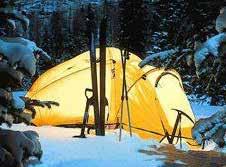

breakage. Do not stand until you’ve reached the ground or more solid ice.
5. Use safety tools: If you’re planning to be on ice, take safety gear. A few items you might need include a safety whistle, some sort of ice pick or claw-like traction tool (used to assist in pulling yourself from the water should you fall through), a personal flotation device and rope. Other items include an ice spud (checks for ice consistency ahead of you), ice cleats (prevents slippage), warm clothes and a blanket, and a communication device.
6. Watch for snow-covered ice: If doesn’t take much snow to hide thin ice. This is one reason why it’s always best to stay on trails when exploring. Be aware of depressed river beds, the sound of rushing water and large, flat areas amid otherwise textured terrain.
7. Don’t run to the rescue: If someone you’re with falls through the ice, don’t rush their way. If the ice is thin enough for them to fall through, there’s a good chance it won’t support you either. Instead, assist from a safe distance. If you have a rope or flotation device, get it their way. Help talk them through the steps of self-recovery and call 911 as soon as possible.
8. Ice is never completely safe: Because some factors aren’t visible to the observable eye, it’s important to know that anytime you’re on ice, there’s a risk. Proceed with caution.
9. Know what to watch for: Ice is not consistent across a body of water. Some signs that can reveal weak ice include ice around partially submerged objects, cracks, slush, darker areas, thin edge ice and snow-covered ice.
perfect spot for all of
While frigid air and frosty conditions grip much of Colorado, some quadrants stay relatively dry and balmy come winter.
Consider this your guide for a possible escape.
Mountain bikers rejoice: the Royal Gorge region finds itself along a banana belt that ensures a warmer climate.

Over the past decade, Cañon City has seized the opportunity to expand singletrack that’s typically more rideable than the dirt north in Colorado Springs. The Oil Well Flats and South Cañon networks put the area on the map, while nonprofit Fremont Adventure Recreation has more recently been focused on building trails on the north rim of the Royal Gorge. Check that group’s website for up-to-date trail conditions.
Those places can be hiked, too. Another option on foot is Tunnel Drive, touring historic rock passages above the Arkansas River. Another option, of course, is Royal Gorge Bridge & Park. The iconic bridge and attractions stay open year-round. The Royal Gorge Route Railroad offers Christmas-themed train rides.
Winter could be prime time to book a reservation at the revamped Desert Reef Hot Springs closer to Florence. Cañon City’s neighboring town calls itself Colorado’s Antique Capital and also has vied to be the culinary capital, with a surprising mix of cuisine clustered in the little downtown.
The Western Slope desert has been a mountain biking destination since the 1990s, when a ragtag bunch of riders saw great promise in the surrounding sage fields and canyonlands. Fruita saw its fortunes reverse as a base camp for the Kokopelli and Lunch loops, along with 18 Road and greater Rabbit Valley trails.
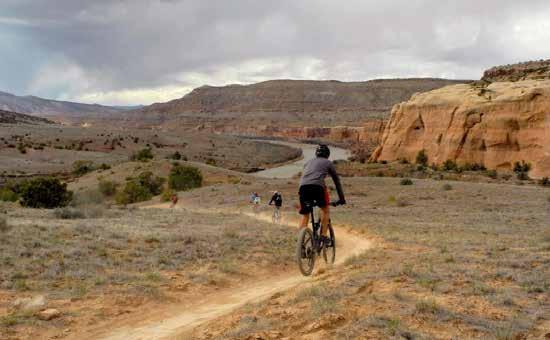
The famed red rocks of Utah across the border seem to overshadow the similar magnificent formations making up Colorado
National Monument.
“Winter is an amazing time to come,” Arlene Jackson, the preserve’s chief of interpretation, told us. “We get a little bit of snow. The road is rarely closed over the top.”
The 23-mile Rim Rock Drive spans between Fruita and Grand Junction, with plenty of overlooks and hiking possibilities along the way. Equally endless are the possibilities in Grand Junction, including the golf courses that stay open during winter.
On the other end of the valley, you won’t find the fruit trees blooming, but you’ll still find amazing flavors around Palisade’s restaurants and wineries.
Lake Pueblo is a destination of water in the summer. In the winter, it’s a destination of land.
Mountain bikers cherish the rocky terrain by the shores. For hikers, Arkansas Point is an easy-to-reach precipice with panoramic views. Campgrounds stay open through winter, granting you a longer stay to spot bald eagles that soar here from mid-December to March.
In town, the Arkansas Riverwalk is a must-do. Pueblo calls the 32-acre waterfront venue its gem, a restful retreat near downtown that’s inspired by San Antonio.

Afterward, you can warm up with the legendary slopper. Gray’s Coors Tavern is believed to be the birthplace of the burger smothered in green chili. The tradition is to wash it down with a schooner of beer. Another local institution is Pass Key, home of “the best Italian sausage sandwich in the world.”
For history buffs, check out El Pueblo History Museum and the Pueblo Weisbrod Aircraft Museum.
